#a good ANZAC Day to all Australian and New Zealanders out there
Text
19 June 2023
The Imperial Metropolis
London
19 June 2023
So I was just settling into bed tonight, thinking about what I needed to do tomorrow, when I had an inkling that I’d forgotten to do something. Something important. Now, I’d had my meds, so it wasn’t that, I’d eaten dinner, showered, all that good stuff, so what could it be?
Oh. Right. Log.

I woke up very early this morning to get the train from Edgware to Victoria, meeting the group at our hotel just before nine. We proceeded from there to Westminster Cathedral, briefly exploring that building and looking at the Martyr’s Memorial within, before carrying on to the somewhat more famous Westminster Abbey. After a brief interrogation of the statuary on Parliament Square, we went inside.
I highly doubt Westminster Abbey needs an introduction - it’s Britain’s most famous church, and dozens of kings and dignitaries are buried inside. To this day, Britain’s heroes are commemorated in these hallowed walls - Isaac Newton lies next to Stephen Hawking, and there’s Prime Ministers from Pitt to Wilson. It’s absolutely packed, of course, but I’d say it’s well worth a look. The main reason we visited, of course, was the Tomb of the Unknown Warrior, the representative of all Britain’s (and previously the Empire’s) war dead. It is interesting, considering the secular nature of most WWI commemoration, just how Christian the tomb is - but I suppose it ought to be, given its place in an abbey. Still, one must remember that he ostensibly represents the Catholic and Jewish soldiers of Britain, not to mention the Hindus and Muslims of the Indian Army.

After the Abbey, we proceeded up Whitehall, looking at the Cenotaph, the Women’s Cenotaph for the Second World War, and the statue of Field Marshal Haig. We went through Horse Guards (Life Guards on duty today) and observed the memorial to the Foot Guards, and then carried on via the Royal Marines Memorial next to Admiralty Arch (a Boer War Memorial, as I can’t escape my thesis topic) to Trafalgar Square. We broke for lunch here, and I had mine in the crypt beneath St. Martin’s in the Field church. It was a nice little cafe, and only a few sandbags and posters away from looking like something right out of the Blitz. Maybe I shouldn’t give them ideas.
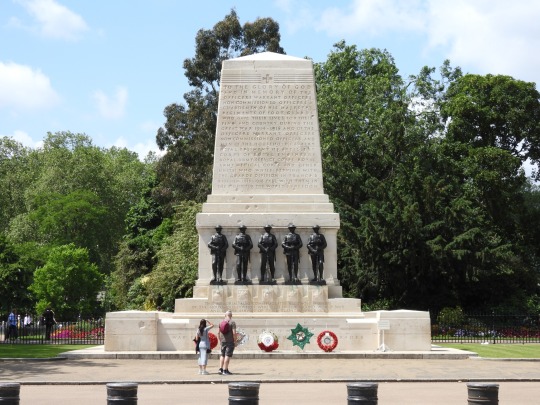
After lunch, we looked at the Edith Cavell Memorial. Cavell, for the uninitiated, was a British nurse in Belgium shot for supposed espionage on 12 October 1915 - the monument is tall and heroic, a real ‘King and Country’ sort of thing; the words are even emblazoned on it. This makes the addition of a quote from Cavell in the 1920s - “Patriotism is not enough. I must have no hatred in my heart for anybody.” - a rather curious juxtaposition. Still, it is well worth a look if one is at Trafalgar Square.
From St. Martin’s, we walked down to the Victoria Embankment Park, where a small memorial to the Imperial Camel Corps is situated. There was a brief discussion of Australian troops on leave in London, and then we carried on back up to the Strand and over to Australia House. Australia House, they say, is ‘our house’ in London; but security arrangements had fallen through, preventing us from going inside. Canada and New Zealand, we were told, are not so paranoid about security, and we would have had no problem going inside.
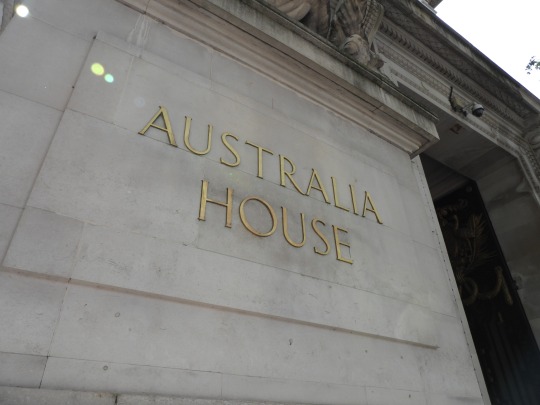
On the other side of the road was the St. Clement Danes Church, which served as a centre for Anzac and Armistice Day services for Australians in London during the interwar years. Today it’s the official church of the Royal Air Force. Statues of Air Marshals Dowding and ‘Bomber’ Harris stand sentinel outside, and the floor is marked with the crests of various RAF, RAAF, RCAF, RNZAF and affiliated squadrons. A panel lists the RAF’s VC and GC holders - notably Guy Gibson, commander of the Dams Raid in May 1943. Gibson’s been in the news lately - the conversion of RAF Scampton into a refugee torture chamb- I mean internment centre has placed his office and the grave of his dog under threat. Many people are very emotional about this grave - yet, in an absurdly farcical situation, they absolutely cannot mention it’s name. (The dog was black. The name rhymed with trigger. I’m sure you can put this one together.)
We broke up shortly after, and after a quick visit to Foyles and a brief rest at the hotel, I went with the professor and a few others to Skygarden. This is basically a garden and cafe on top of a skyscraper, and the views are spectacular. Best of all, entry is free. On the way home I fell down the stairs at Monument, and now there’s a big lump on my left arm. These things happen I suppose.

Tomorrow, we head to Green Park to interrogate the memorials there, before spending the lion’s share of the day at the Imperial War Museum. If it goes anything like today did, it’ll be a blast.
#first world war#british empire#british army#australia#australian imperial force#anzac#boer war#second world war#london#edith cavell#westminster abbey
12 notes
·
View notes
Text
In 2115 will we still commemorate Anzac Day like we do today?
Anzac Day 1916 was a very different ANZAC Day compared to that I experienced in Canberra this morning. Martin Crotty, a historian at the University of Queensland, said that Anzac Day commemorations have “suited political purposes right from 1916 when the first Anzac Day march was held in London and Australia, which were very much about trying to recruit more people to join the war during 1916-1918.”
As war efforts changed over the last 109 years, and eventually subsided, the Anzac Day commemorations have taken on a more solemn and meaningful practice. After attending the 2024 Dawn Service at the Australian War Memorial this morning–my first in Canberra, and possibly my fifth as an adult–I have some thoughts.
I’m not going to discuss how I thought arriving half an hour early for a 5:30 am service would be “early enough” to secure a good viewpoint–it was not, and I’m pretty sure that most of the 30,000 attendees beat me to the Sculpture Garden this morning. Nor will I mention how the lacklustre audio and video production at the memorial left me feeling blind and deaf, yet my hearing was sharp enough at 5:30 am to hear someone vomiting behind me and a staff member using one of those hand-held clickers commonly used by bouncers, walking through the crowd in the dark, clicking away.
I won’t wax lyrical about how the male performers were named and the master of ceremonies asked the crowd to applaud them, yet the female performers were neither named nor acknowledged.
Where my mind is at, here in the Canberra Qantas Lounge at 4pm on the twenty-fifth of April, is the book I’m currently seven percent through on my Kobo e-reader, “Van Diemen’s Land” by James Boyce, and a PhD candidate from Turkey who was ahead of me in line for a bacon and egg roll after the service.
The PhD candidate studying tourism in Turkey has come to Australia for a few weeks to complete his study on why Australians aren’t visiting Gallipoli for Anzac Day anymore. Apparently, for the centenary in 2015, over 40,000 Australians and New Zealanders made the pilgrimage, but numbers have significantly dropped, to about 1,500 last year.
I can’t shake the feeling that Anzac Day needs to continue to evolve.
In 2115, are we expecting our great-grandchildren to be trekking to Gallipoli, or even to the Australian War Memorial, to remember the events of April 1915?
Or can the spirit of Anzac Day start to embody more of the Australian spirit, leading me to James Boyce’s “Van Diemen’s Land”?
The thorough rewriting and retelling of Tasmania’s history should be a must-read for all Australians–not for the interest in the Apple Isle–but for a thorough understanding of the relationship between the first Australians, the early whalers and sealers, the French, the Dutch, and the British.
I was sold a narrative as a child that there was nothing here on Terra Australis except for some savages until the Brits arrived, and then some things happened, then we got Channel V. My little brother was born in 1988, so he got a cool birth certificate because the country was 200 years old, and I got a trip to Expo ‘88. Simpler times.
Modern brave and valiant efforts to flesh out that story with truth, to include First Australians, their sovereignty, and their story, have undoubtedly helped me understand more about the brutality inflicted by the early settlers and the sudden change to the Aboriginal way of life– one day they’re living their hashtag bestlife, and the next, some guy is waving a metal rod of murder towards them, killing some of their friends and family.
James Boyce’s nuanced approach to the 18th and 19th-century tension has led me to a greater understanding of the times. An understanding that softens the often poisonous narrative about the early explorers and convicts, acknowledging that they were strangers in a new and foreign land, and also that the locals were being impacted by strangers in their homeland.
One simple story that greatly impacted me was about how back-burning was misunderstood. We now know that Australian Aborigines are experts in land and bushfire management, and we also have evidence that being caught in a bushfire isn’t exactly conducive to survival. In what would be one of the earliest misunderstandings between local Aboriginals and settlers, the Aboriginals were back-burning on their land, as was their right and responsibility, but the British were terrified and believed they were under attack from the Aboriginals.
There are countless other stories from that time of the early explorers, soldiers, and convicts having extremely positive relationships with the First Australians.
But the scarlet thread through it all are tensions between the nations and their people.
The path of reconciliation made its way into the twentieth century where the First Nations people of Australia fought alongside the first immigrants of Australia in World War I, albeit paid dismally and treated worse, and still today our people struggle with that tension between our peoples, working feverishly to close that gap and heal the wounds.
I was reminded of that as one of the speakers at the War Memorial dawn service this morning recounted the 1944 story of the Battle of Leyte Gulf in the Philippines, where HMAS Australia was attacked by the Japanese.
In 2024, Japan is the number one nation Australians are visiting–willingly, for leisure and fun–only 80 years after we lost thirty Australians to a Japanese kamikaze aircraft attack.
The story I see being told on Anzac Day 2115 is a story of principles being held and fought for, and tensions being identified and resolved, a story of reconciliation.
Perhaps today we can start sharing that beautiful, rich, and rare story of resolved tension, principles of treaty between the First Australian nations and those of us who come across the seas for the boundless plains to share. May we advance Australia fair.
0 notes
Text
Australia Public Holidays 2023 | Australia Holidays 2023
In this article, we will explore significance Australia public holidays, their historical origins, and the diverse ways they are observed across the country, capturing the essence of the Land Down Under.
Australia, a vast and diverse country known for its stunning landscapes, rich cultural heritage, and laid-back lifestyle, celebrates a range of public holidays throughout the year. These holidays are a reflection of the nation's history, traditions, and values, bringing Australians together to revel in festivities, leisure, and national pride. From iconic national holidays that unite the entire country to regional events that showcase local customs, Australia's public holidays offer a delightful tapestry of celebrations.
Here you can checkout Australia public holidays.
Australia Day - Celebrating the Nation's Spirit
Australia Day, observed on January 26th, is one of the most significant public holidays in Australia. It commemorates the arrival of the First Fleet in 1788, marking the beginning of British colonization. Today, Australia Day is a celebration of national identity, cultural diversity, and achievements. Across the country, citizens come together for barbecues, beach outings, and community events, expressing their pride in being Australian and embracing the spirit of mateship.

Anzac Day - Honoring the Sacrifices of the Brave
Anzac Day, held on April 25th, is a solemn public holiday dedicated to honoring the Australian and New Zealand Army Corps (ANZAC) who served in wars and conflicts. The day marks the anniversary of the Gallipoli landings in World War I, symbolizing the courage, resilience, and sacrifice of those who fought for their country. Commemorative ceremonies, dawn services, and marches are held across Australia to pay tribute to these brave servicemen and women.
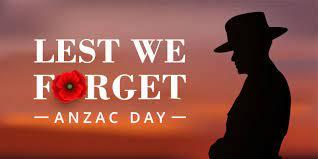
Good Friday and Easter Monday - A Time for Reflection and Rejoicing
Easter in Australia is a significant religious observance celebrated by Christians across the country. Good Friday and Easter Monday are public holidays that provide an opportunity for Australians to engage in both solemn reflection and joyous festivities. Many attend church services and participate in Easter egg hunts, while families and friends gather for feasts, symbolizing the renewal of life and hope.

Queen's Birthday - A Regal Celebration
Queen's Birthday is a public holiday observed on different dates across Australia, typically falling on the second Monday in June in most states. The holiday honors the birthday of the reigning monarch, which has been Queen Elizabeth II in recent years. Australians celebrate the occasion with parades, community events, and cultural performances, showcasing the country's historical ties to the British monarchy.

Christmas - Spreading Festive Cheer
Christmas in Australia is a cherished holiday marked by a unique blend of traditions, reflecting the country's warm climate and outdoor lifestyle. Despite the absence of snow, Australians celebrate with decorations, caroling, and festive lights. Many enjoy "Aussie" Christmas barbecues, beach outings, and cricket matches, creating a joyful and relaxed atmosphere of togetherness.
Labour Day - Recognizing Workers' Contributions
Labour Day is celebrated on different dates across Australia, with each state observing the holiday on different occasions. It commemorates the labor movement's achievements in securing better working conditions and fair wages. Labour Day is marked with parades, family-friendly activities, and community events that highlight the contributions of workers to the nation's prosperity and progress.
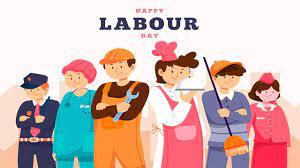
The holiday season is a time of joy, giving, and spreading goodwill to all. Goodwill, a renowned thrift store chain, understands the significance of providing convenient shopping opportunities during this festive period. To accommodate their valued customers’ needs and ensure a seamless shopping experience.
Conclusion
Australia's public holidays form an essential part of the nation's cultural fabric, representing its history, diversity, and values. From the patriotic celebrations of Australia Day to the somber remembrances of Anzac Day and the joyous festivities of Christmas, each holiday reflects the unique spirit of the Land Down Under. By participating in these celebrations, both Australians and visitors can embrace the warmth, camaraderie, and national pride that make Australia's public holidays a cherished and vibrant tapestry of festivities.
0 notes
Photo

"Fratricide In The Fog Of War" Eighty Years Ago Today - The night of Saturday the 13th into Sunday the 14th, approximately 400 miles soutth of Cape Palmas, Liberia, Africa: The 21,500 ton "SS Empress Of Canada" is running south. A beautiful pre-war ocean liner, she's been pressed into service as a troop ship. Her primary route for the last three years has been hauling Australian and New Zealand ("ANZAC") Soldiers across the Indian Ocean, around Cape Horn, and allllll the way up the west coast of Africa to the combat zone in Europe and the Mediterranean. On the return voyage, available space is used efficiently. Specifically, there are 1,800 souls on board her. She's carrying refugees from Poland and Greece, along with a large number of Italian prisoners. If you're already thinking this can't be good, and something is about to go wrong, you're correct. Out of nowhere comes a torpedo spread, not from a German U-Boat, but the "Leonardo da Vinci," a Marconi-Class submarine of the Regia Marina, the Fascist Italian Navy. The hits are fatal... Empress Of Canada goes to the bottom in shark infested waters. The sinking and the sharks take their toll, but incredibly, for all those onboard, casualties are "relatively" light under the circumstances - only 392 dead. Sadly, in this act of fratricide, 149 of those are some of the Italian POWs. Just another day... 🇺🇲🇺🇲 ** Please Like & Follow "Sandy Hook History" on Facebook & Instagram for more amazing maritime and military histories of the Garden State and New York Harbor as well as a review of the 80th Anniversary of the Battle Of The Atlantic and World War 2** 🇺🇲🇺🇲 Photos: 1,nineteenkeys.blogspot.com; 2, sharkattackfile.net #visitmonmouth #newjerseybuzz #thejournalnj #locallivingnj #journeythroughjersey #centraljerseyexists #discovernj #yesnj #newjerseyhistory #newjerseyforyou #sandyhookbeach #sandyhooknj #sandyhookhistory #forthancockhistory #forthancock #battleoftheatlantic #empressofcanada #oceanliner #canadianpacificsteamships #canadianpacific #leonardodavinci #marconiclass #regiamarina #fascistitaly #fratricide #troopship #torpedoattack #sharkattack #lifeboat #lifeboats (at Fort Hancock, New Jersey) https://www.instagram.com/p/Cpy37-Rtnar/?igshid=NGJjMDIxMWI=
#visitmonmouth#newjerseybuzz#thejournalnj#locallivingnj#journeythroughjersey#centraljerseyexists#discovernj#yesnj#newjerseyhistory#newjerseyforyou#sandyhookbeach#sandyhooknj#sandyhookhistory#forthancockhistory#forthancock#battleoftheatlantic#empressofcanada#oceanliner#canadianpacificsteamships#canadianpacific#leonardodavinci#marconiclass#regiamarina#fascistitaly#fratricide#troopship#torpedoattack#sharkattack#lifeboat#lifeboats
0 notes
Text
So, I Hear You Liked: 1917
More World War One Films
I was very excited about 1917 when it first came out because it almost perfectly coincided with the 100th anniversary of the First World War, a conflict that I love to read about, write about, and watch movies about. This period is my JAM, and there's such a lot of good content for when you're done with Sam Mendes's film.
Obviously there are a lot of movies and TV shows out there - this is just a selection that I enjoyed, and wish more people knew about.
Note: Everyone enjoys a show or movie for different reasons. These shows are on this list because of the time period they depict, not because of the quality of their writing, the accuracy of their history or the political nature of their content. Where I’m able to, I’ve mentioned if a book is available if you’d like to read more.
I'd like to start the list with a movie that isn't a fiction piece at all - Peter Jackson's They Shall Not Grow Old (2019) is a beautifully produced film that allows the soldiers and archival images themselves, lovingly retimed and tinted into living color, to tell their own story. It is a must watch for anyone interested in the period.
Wings (1927), All Quiet on the Western Front (1930), A Farewell to Arms (1932, 1957), The Dawn Patrol (1938), Sergeant York (1941), and Paths of Glory (1957) are all classics with a couple of Oscars between them, and it's sort of fun to watch how the war gets changed and interpreted as the years pass. (The Dawn Patrol, for instance, might as just as easily be about the RAF in World War 2.)
All Quiet is based on a famous memoir, and A Farewell to Arms on a Hemingway novel; both have several adaptations and they're all a little different. Speaking of iconic novels, Doctor Zhivago (1965) based on the Pasternak novel of the same title, examines life of its protagonist between 1905 and the start of the second World War.
I think one thing historians agree on is that the start of World War One is worth discussing - and that there's a lot of backstory. Fall of Eagles (1974), a 13 part BBC miniseries, details the relationships between the great houses of Europe, starting in the 1860s; it's long but good, and I think might be on YouTube. The Last Czars (2019) takes a dramatized look at the Romanovs and how their reactions to the war lead to their eventual demise.
As far as the war itself, Sarajevo (2014) and 37 Days (2014) both discuss the outbreak of hostilities and the slow roll into actual battle.
The Passing Bells (2014) follows the whole war through the eyes of two soldiers, one German and one British, beginning in peacetime.
Joyeux Noel ( 2005) is a cute story - it takes place early in the war during the Christmas Peace and approaches the event from a multinational perspective.
War Horse (2011) is, of course, a name you'll recognize. Based on the breakout West End play, which is itself based on a YA novel by Michael Morpurgo, the story follows a horse who's requisitioned for cavalry service and the young man who owns him. Private Peaceful (2012) is also based on a Morpurgo novel, but I didn't think it was quite as good as War Horse.
The Wipers Times (2013) is one of my all-time favorites; it's about a short lived trench paper written and produced by soldiers near Ypres, often called Wipers by the average foot soldier. The miniseries, like the paper, is laugh out loud funny in a dark humor way.
My Boy Jack (2007) is another miniseries based on a play, this one about Rudyard Kipling and his son, Jack, who served in the Irish Guards and died at Loos. Kipling later wrote a poem about the death of his son, and helped select the phrase that appears on all commonwealth gravestones of the First World War.
Gallipoli (1981) is stunning in a way only a Peter Weir movie can be; this is a classic and a must-see.
Gallipoli is a big story that's been told and retold a lot. I still haven't seen Deadline Gallipoli (2015) an Australian miniseries about the men who wrote about the battle for the folks back home and were subject to censorship about how bad things really were. For a slightly different perspective, the Turkish director Yesim Sezgin made Çanakkale 1915 in 2012, detailing the Turkish side of the battle. Although most of The Water Diviner (2014) takes place after the war is over, it also covers parts of Gallipoli and while it didn't get great reviews, I enjoy it enough to own it on DVD.
I don't know why all of my favorite WWI films tend to be Australian; Beneath Hill 60 (2010) is another one of my favorites, talking about the 1st Australian Tunneling Company at the Ypres Salient. The War Below (2021) promises to tell a similar story about the Pioneer companies at Messines, responsible for building the huge network of mines there.
Passchendaele (2008) is a Canadian production about the battle of the same name. I'd forgotten I've seen this film, which might not say very much for the story.
Journey's End (2017) is an adaptation of an RC Sheriff play that takes place towards the end of the war in a dugout amongst British officers.
No look at the Great War is complete without a nod to developing military technologies, and this is the war that pioneers the aviation battle for us. I really wish Flyboys (2006) was better than it is, but The Red Baron (2008) makes up for it from the German perspective.
One of the reasons I like reading about the First World War is that everyone is having a revolution. Technology is growing by leaps and bounds, women are fighting for the right to vote, and a lot of colonial possessions are coming into their own, including (but not limited to) Ireland. Rebellion (2016) was a multi-season miniseries that went into the Easter Rising, as well as the role the war played there. Michael Collins (1996) spends more time with the Anglo-Irish war in the 1920s but is still worth watching (or wincing through Julia Roberts' bad accent, you decide.) The Wind that Shakes the Barley covers the same conflict and is excellent.
The centennial of the war meant that in addition to talking about the war, people were also interested in talking about the Armenian Genocide. The Promise (2016) and The Ottoman Lieutenant (2017) came out around the same time and two different looks at the situation in Armenia.
This is a war of poets and writers, of whom we have already mentioned a few. Hedd Wynn ( 1992) which is almost entirely in Welsh, and tells the story of Ellis Evans, a Welsh language poet who was killed on the first day of the Battle of Passchendaele. I think Ioan Gruffudd has read some of his poetry online somewhere, it's very pretty. A Bear Named Winnie (2004) follows the life of the bear who'd become the inspiration for Winnie the Pooh. Tolkien (2019) expands a little on the author's early life and his service during the war. Benediction (2021) will tell the story of Siegfried Sassoon and his time at Craiglockhart Hospital. Craiglockhart is also represented in Regeneration (1997) based on a novel by Pat Barker.
Anzac Girls (2014) is probably my favorite mini-series in the history of EVER; it follows the lives of a group of Australian and New Zealand nurses from hospital duty in Egypt to the lines of the Western Front. I love this series not only because it portrays women (ALWAYS a plus) but gives a sense of the scope of the many theatres of the war that most movies don't. It's based on a book by Peter Rees, which is similarly excellent.
On a similar note, The Crimson Field (2014) explores the lives of members of a Voluntary Aid Detachment, or VADs, lady volunteers without formal nursing training who were sent to help with menial work in hospitals. It only ran for a season but had a lot of potential. Testament of Youth (2014) is based on the celebrated memoirs of Vera Brittain, who served as a VAD for part of the war and lead her to become a dedicated pacifist.
Also, while we're on the subject of women, though these aren't war movies specifically, I feel like the additional color to the early 20th century female experience offered by Suffragette (2015) and Iron-Jawed Angels (2004) is worth the time.
As a general rule, Americans don't talk about World War One, and we sure don't make movies about it, either. The Lost Battalion (2001) tells the story of Major Charles Whittlesey and the 9 companies of the 77th Infantry division who were trapped behind enemy lines during the battle of the Meuse Argonne.
I should add that this list is curtailed a little bit by what's available for broadcast or stream on American television, so it's missing a lot of dramas in other languages. The Road to Calvary (2017) was a Russian drama based on the novels of Alexei Tolstoy. Kurt Seyit ve Şura (2014) is based on a novel and follows a love story between a Crimean officer (a Muslim) and the Russian woman he loves. The show is primarily in Turkish, and Kıvanç Tatlıtuğ, who plays the lead, is *very* attractive.
Finally, although it might seem silly to mention them, Upstairs Downstairs (1971-1975 ) Downton Abbey (2010-2015) and Peaky Blinders (2013-present) are worth a mention and a watch. All of them are large ensemble TV shows that take place over a much longer period than just the Great War, but the characters in each are shaped tremendously by the war.
#so i hear you liked#preaching the period drama gospel i am#world war one#period drama#period drama trash#1917
68 notes
·
View notes
Text
An answer I just wrote for r/askhistorians on the question “To What Extent was the Allies failure at Gallipoli the Result of poor planning and logistics?”
Poor planning and the difficulty of supplying the Mediterranean Expeditionary Force (MEF) certainly amplified the problems faced by General Ian Hamilton during the Gallipoli campaign, but the British (I use the term to cover all Empire forces here) ran into the same broad problems that pretty much all armies faced during the first half of the war. Namely; lack of an exploitation ability, lack of battlefield communication and troops who were neither properly trained or equipped for the fighting they faced. If the Allies couldn't succeed quickly, then the inevitable First World War problem would happen. Reinforcements would be rushed in and stalemate would ensue.
I'm going to ignore the question of whether the goal of the campaign was correct or even achievable, and focus more on what problems the British faced in trying to achieve that goal. Basically the idea was to use land forces to clear the coastal defences of the Gallipoli peninsula to allow Allied ships to clear the mines that blocked passage through the Dardanelles.
To do this Hamilton was given four divisions of infantry, (29th Division the only regular division, Royal Naval Division a real hodge podge of units made up of sailors, naval base men and reserves, the 1st Australian Division and the New Zealand and Australian Division [NZ&A Division]) about 80,000 men.
Instead of attacking at the narrowest part of the peninsula, Bulair, which was very heavily defended, Hamilton decided to land at Cape Helles in the south which was closer to the forts and where there were far fewer Ottoman units stationed, and which was further from reinforcements. Another attack was planned along the north coast at a place which became known as Anzac Cove. The attack in the north was intended to cross the peninsula in another narrow section and block off the reinforcement and escape of troops further in the south, whilst still removing the troublesome coastal forts. This in theory would only take a few days.
So why didn't it work?
Well to start with the troops Hamilton had were far from the best. The 29th Division was by far his best formation as it was made up of units that had been garrisoning various colonies before the war and was full of veteran troops. The Royal Naval Division was more or less a New Army division, created at the wish of Winston Churchill from naval reservists and volunteers who joined in 1914. It lacked experienced officers and NCOs and apart from some of its 3rd Marine Brigade, it had no campaign experience and little training. The two Dominion divisions were little better. Also raised from volunteers of 1914 they were enthusiastic but poorly led, trained and equipped. The Cambridge Military history of Australia goes as far as to say that "the 1st Division was probably the worst-trained formation ever sent from Australian shores." Although the rank and file troops were of good physical quality, their leaders were often too old and lacked campaign experience, and they suffered the same equipment deficiencies that all British forces did in 1915, particularly in machine guns, grenades, mortars and artillery. The NZ&A Division had all of the problems of the purely Australian division, with the added difficulty of being a composite force being led not by a Kiwi or Aussie, but by an English general, Sir Alexander Godley. This was put against three Ottoman divisions on the Peninsula, and with the recent memory of the Balkan wars the British vastly underestimated the fighting quality of Ottoman troops.
Any military operation is difficult, but amphibious landings are probably the hardest of all and there were problems at more or less every level of the actual operation. There weren't a lot of good maps, and what maps there were had to be copied, which inevitably turned out poor quality maps for most of the British forces, particularly for battalion commanders and below. Cooperation between navy and army wasn't particularly good either. Neither Hamilton nor Admiral John de Robeck were great communicators and de Robeck was apparently quite indecisive, leaving it to Hamilton to make plans that involved naval cooperation, such as command over the landing beaches, the landing order of units and stores. Naval gunnery has never really been a British strong point, and it showed at the landings. Some of this though was due to the difficulty of the terrain, as the flat trajectory of naval guns couldn't hit Ottoman positions on the rear of hills.
As for the troops, they ran into the obvious problems. Apart from parts of the 29th Division, command and control largely broke down. Particularly in the scrubby gullies of Anzac Cove, troops became mixed up from their units, officers got lost, became casualties or simply had no idea of what to do and troops lacked the discipline and knowledge to take advantage of the almost equal level of disorganisation amongst the Ottoman defenders. Once resistance stiffened men went to ground and trenches started to be dug. Due to the chaos and heavy casualties, particularly from unopposed Ottoman artillery, the attacks stalled. Even where they were successful British troops lacked the ability to exploit that success as either they lacked clear orders or were ordered to hold their current positions until the situation became clear. Once trenches had been dug though, they pretty much stayed there, despite the best efforts of both sides. Once the British attacks had been halted they never really moved again until the evacuations over the winter.
I'm basically of the opinion that after the first day the British lost any real chance at success, which was exceedingly slim to begin with. So TLDR;
Planning failures: Lack of intelligence in maps, positions, understanding of terrain (I haven't really emphasised enough how difficult it was, particularly at Anzac), lack of inter-service cooperation, lack of experienced staff officers, lack of training and experienced troops.
Logistical failures: Lack of suitable artillery. Again, I haven't really mentioned it enough but there artillery problems were severe. There wasn't much artillery, and what there was was mostly flat trajectory field guns, not high angle firing howitzers. Hamilton and his staff were constantly begging the War Office for more howitzers and high explosive ammunition, as they had not enough of either. Water was scarce on the peninsula and had to be rationed. Fresh food was more or less unavailable which, along with poor sanitary conditions, led to high rates of disease, particularly dysentery. Lack of modern weaponry. The Ottoman forces were being supplied with German grenades and mortars while the British had neither and were forced to improvise, famously with the 'jam tin bomb'. Even if the Ottomans didn't have a perfect doctrine for their use, they at least had them while the British did not. And all of this was at the end of a very long supply chain. Some food and water could be acquired from places closer by like Egypt, but most military supplies had to come from Britain and took weeks or months to arrive.
Planning and logistics always play a role in the outcome of a campaign, often a decisive one. Gallipoli is kind of a perfect storm of everything going wrong, including but not limited to planning and supply.
#ww1#wwi#great war#world war 1#gallipoli campaign#british army#australian army#ANZAC#hiscourse#military history#history
35 notes
·
View notes
Text
The Great Anzac Bake-Off
"Is that all you're having?" Stephen frowned. "It doesn't look very filling."
"It is a biscuit made of oats and baked in heavy syrup and butter. I assure you, it is more filling than your three-egg quinoa omelette," Loki mumbled as he nibbled on his sweet treat at an agonisingly slow pace. "It was certainly enough to fill the bellies of tens and thousands of soldiers back in the first World War. How kind of Darryl to remind me."
Stephen went quiet.
"I worry about you sometimes," he confessed.
"Why in the Nine would you?"
“Worry is too strong a word…” Stephen muttered. “Wonder, maybe.”
He watched Loki listlessly stir the cold milk with the cookie clockwise, then, anticlockwise several times.
"I wonder where you are," Stephen finally mumbled to himself.
"I had no idea your eyesight was so bad," Loki sniffed. "I am right here."
"No, I mean...temporally speaking," Stephen said. "Your headspace doesn't sound like it's in the 21st century right now."
"Maybe it isn't."
Loki's sullen mood was a far cry from the ray of sunshine that had waltzed in through the Sanctum's front door that morning. Stephen wondered if he had upset Loki when he refused to partake in the gift of baked goods Loki had brought with him from New Asgard.
"It was my turn to cook for our breakfast date this week," Stephen reminded.
Loki shrugged and said nothing.
At the sight of Loki's crestfallen face, Stephen's resolve faltered. He was not a fan of sweets but...
"I'll have some later, okay?" Stephen placated. "They look sweet but I have braved far worse."
"Are we talking about the famine soup again?" Loki asked, stone-faced. "I was only paying tribute to my dear friend Alexis.”
At the look of confusion on Stephen’s face, he queried incredulously, “Alexis Soyer? You do not know of him?”
“Should I?” Stephen returned coolly.
“He was the unsung hero of the hungry and the poor. His soup kitchen fed thousands of starving Irish for free during the Great Irish Famine."
The facade cracked, and an embarrassed flush coloured Stephen’s cheeks.
"No, I get it. I just…" he searched for the right words to say but he only ended up hesitating for far too long. "I guess I'm trying to figure out where I fit in."
"You need to stop being jealous of every dead friend I once had, Stephen."
Stephen had to center himself and think. Loki's thought process was difficult enough to follow on a normal day. A nostalgic Loki's was next to impossible, but Loki only ever said Stephen's name in that tone whenever he felt personally affronted.
"That is not what I meant at all," Stephen said apologetically
Loki crossed his arms over his chest. "Then what did you mean?"
"There are times when I'm talking to you and it feels like I'm talking to a different you. A you from another time."
"Is that concerning?" Loki wondered aloud. The minimal shrug he gave a split-second later belied the deep frown on his face. "For you, maybe."
Stephen had learnt from experience that the quickest, most effective (if not the least painful) method to break down Loki’s walls was by appealing to his inherent sentimentality...and the way to do it was by being very honest.
Stephen mustered the courage to raise his head and look Loki right in the eye. “Yes, it is very concerning. I don’t want to lose you, Loki.”
The last of the cookie slipped from between Loki’s fingers and plopped into the milk.
“...That’s utterly ridiculous,” Loki said unconvincingly after a while. He fumbled with a teaspoon to dig the biscuit out but the harder he tried, the more it dissolved in the milk.
He gave up and threw the spoon across the table, inadvertently splashing droplets of milk everywhere and splattering Stephen’s arm in the process.
Without thinking, Loki reached out and irately wiped the back of Stephen’s hand with the sleeve of his tunic. “Why would you say such things?”
Stephen’s unhappy countenance was damning in its silence.
“Say something,” Loki forced through crumbling layers of pride and gritted teeth.
Stephen’s gaze shifted, looking anywhere but the eyes peering anxiously at him.
“I wonder of the stories you would tell when I’m gone. I wonder if you would think of me at all.”
Loki heaved a longanimous sigh.
“Oh, Doctor." He gave the back of the now-clean hand an awkward pat. "It is only a biscuit.”
"Is it?" Stephen asked sadly.
Loki studied the thin line of Stephen's lips, and how the blue irises had darkened to a slate gray under eyes more hooded than usual.
“Is it really that bad?” Loki asked softly. "My sharing the sweetness of the past with you?”
"Call me selfish, but I'd rather we work on our own story. For the future."
That caught Loki by surprise. "Do you foresee one with me?"
The clock on the wall mocked Loki with every ticking of the second hand.
With a sneer as bitter as his smile, he scoffed, "Of course. Your lips are sealed. I didn't know what I was expecting."
"Everything I have ever said to you is the truth," Stephen said.
"A curated truth," Loki spat. "A lie would be much kinder."
"I love you," Stephen said sharply. "I didn't lie about that."
"I cannot think of the future when I am with you, Strange," Loki snapped. "Not with you knowing what you know."
"Then think of the present," Stephen pleaded. He reached for Loki's hand. "Be in the present.”
“We’re all relics in the end," Loki whispered.
"Until then, be with me," Stephen implored fiercely. "If you won't be mine, just be in the present. With me.”
"I am not lamenting a secret lover who fought and died in the war, Strange," Loki said.
Then who was Darryl? Stephen sorely longed to ask, but Loki beat him to the punch.
"Darryl was Thor's roommate when he was moonlighting in Australia some years ago. I stole these from the box of goodies he must have sent my Brother for Anzac Day."
"Anzac Day?"
"Australian and New Zealand Army Corps. To commemorate their fallen in the Gallipoli Campaign in World War I and in all the allied campaigns thereafter, their countrymen bake biscuits."
"Surely that is not all they do."
"It is no different than the libation we used to drink to honor Odin's chosen heroes on the Feast of the Einherjar," Loki said, his eyes taking on a thousand-yard stare. "It is a tradition that has endured the test of time."
With that last revelation, Loki visibly shrank in his seat; he looked small and young and yet every one of his thousand-odd years.
"The recipe has remained unchanged for over a hundred years," Loki mumbled. "I brought some for I had wished to share them with you."
The sweetness of the past, Loki had said.
And Stephen had ruined it all in a fit of petty jealousy.
He grabbed the last biscuit out of the plastic box and took a bite. For an oat biscuit, it was very crunchy.
"This isn't a biscuit," he mumbled through a mouthful of crumbs. "It's a cookie."
Loki watched Stephen chew with wary eyes still steeped in hurt.
"It's protected under food naming regulations. Calling it a cookie could earn you a heavy fine."
"Seriously?"
"Do you like it?"
"It's...sweet." Stephen drilled the tip of his tongue into one of his back molars. "It might have just given me a cavity."
Loki laughed a soft, tinkling chuckle that momentarily returned the light to his eyes. But to Stephen's great dismay, the mirth did not last for long.
"You never did ask me properly."
"I could ask it again if I knew which question you're alluding to."
Loki tilted his head curiously. "How can I be yours if you never asked me?"
Stephen licked his lips. For some reason they had gone dry all of a sudden. "Guess I didn't want to come across as a possessive asshole."
"We're fighting over a biscuit you thought I was only eating because I was mourning a dead lover who did not even exist," Loki said flatly.
"Touché." Stephen cleared his throat. "Umm. Are you mine?"
Loki only rolled his eyes. "That's very bold of you."
"Are you?" Stephen asked, painfully aware of how desperate he sounded to his own ears.
"You are putting the onus on me to answer your very one-sided question." Loki shook his head with a disappointed sigh and held out his hand. "Will you give me the rest of that? I don't think you deserve it after all."
"No." Stephen palmed the half-eaten cookie possessively into a fist. What was he doing wrong?
He stared at the outstretched hand in front of him and pondered Loki's request.
Of course.
Stephen closed the palm of his other hand over the long, white fingers. "Loki Odinson…"
Loki stared at him in stunned silence.
At that moment in time, Stephen knew there was absolutely nothing he would not do to dispel the sheer terror from Loki's suddenly red-rimmed eyes.
"Will you give me the honour of calling you mine for the rest of my life?"
The God of Mischief's face had gone almost as white as the curdling milk in front of him.
"Loki? Are you alri - "
Before Stephen could finish, Loki hurled himself across the table and a flurry of arms wrapped themselves tightly around him.
"I will." Loki showered Stephen with kisses on his lips and all over his face, "I will, I will, I will!"
Stephen laughed giddily and he returned Loki's kisses with as much, if not more fervor, every single one of them.
Once they realised they still needed to breathe, they parted reluctantly.
Stephen fingered the hollow of his now-fiancé's cheek. “But the famine soup...really isn’t that nutritious, you know.”
“It’s got bits of meat in it,” Loki argued.
“Which you dug out and hid in your napkin when you thought I wasn't looking,” Stephen chastised lightly. “Then the soup becomes nothing but sugar and flour.”
Loki happily wrapped his arms around Stephen's neck once more. "Will you help me eat it from now on? I can't digest cheap cuts very well and I'd hate to waste perfectly good food."
"For you, babe..." Stephen pulled Loki's face toward him for another kiss, "There's nothing I won't do."
It could be the syrup or it could be true love, but it tasted sweet as hell; now that Stephen could partake in it to his heart's content, he knew he was the most blessed man in the universe.
"I love you, Loki."
"And I, you, Doctor."
Oh, he was blessed alright.
7 notes
·
View notes
Text
Gallipoli (Author’s Notes)
By George deValier
Anzac Day is a national day of remembrance for Australia and New Zealand, the day we remember the first landings at Gallipoli in Turkey during World War One on April 25th, 1915. The day is often considered to mark the beginning of a national consciousness in both countries.
.
To go 'Waltzing Matilda' is to travel by foot, usually in the bush, carrying one's goods in a bag called a 'Matilda.'
.
I hope no one takes Australia's attitude towards England in this story personally. Australian soldiers were well known for being pretty anti-authority (Australians still are) and a lot of the decisions during the Gallipoli campaign that led to losses for the Aussies were (and are) blamed on Britain. But the United Kingdom lost far more men in this war than Australia, and I have never been one of those to blame them for the Australian losses. War is war, and people are people, and thus always want someone to blame.
.
The Gallipoli campaign was a major offensive of World War One, and the first major battle Australia was involved in as a nation (i.e. after the Federation of 1st January, 1901). The objective was to capture the Dardanelle straits in order to secure a sea route to Russia and facilitate a march on Constantinople, knocking the Turks out of the war. It was fought by the Commonwealth forces of England, Australia, New Zealand, India, and Newfoundland, Canada, as well as France and French Africa, against the Ottoman Empire. It lasted eight months, cost 130,000 lives, and ended in failure for the British and French forces.
.
Two-up is a traditional Australian gambling game. It was often played illegally by Australian soldiers in the trenches, and is still illegal in Australia every day of the year except Anzac Day. Playing two-up at an RSL on Anzac Day is definitely an experience every Aussie should have! To play, someone is selected as the Spinner (greeted to loud calls of "Come in Spinner!" by the rest of the players). The Spinner tosses two coins in the air using the kip (a small piece of board). Two heads means the Spinner wins. Two tails means the Spinner loses. Odds "One Them" means the Spinner throws again. If the Spinner loses, another Spinner is chosen. Other members of the group place side bets against each other on whether the Spinner will win or lose. It is all quite mad and chaotic and very hard to regulate!
.
Disclaimer: This story belongs to George deValier. Hetalia belongs to Hidekaz Himaruya. I own nothing.
3 notes
·
View notes
Text
Hero of War
Category: Fanfiction - Hetalia
Characters: Australia (Jett Kirkland), England (Arthur Kirkland), New Zealand (Toby Kirkland), Scotland (Allistor Kirkland)
Rating: T
Warnings: War, violence, offensive language
Originally written: 3 September 2018
Hetalia is a manga/anime in which the various countries of the world have human representations that embody many stereotypes. While some have been given official “human” names (such as England), others have had their names left up to interpretation. For lack of character development, many fans take it upon themselves to add elements to some of the more minor characters.
It wasn't that he regretted it. No; one rule Jett Kirkland tried to live by was to never regret what had already happened. He couldn't change it, after all, and no amount of wishing or pretending would ever do it for him.
All he could do was remember, and honour those memories.
Once again, he ran a finger over the raised red line that spread across the bridge of his nose. Thick-skulled, Arthur had once called him - well, in this case, it had saved his vision, if not his life.
He'd known Artie was in trouble as soon as he'd heard about the war. Despite their differences, Jett had volunteered immediately to help. That was, after all, the Aussie way - when your mate needs a hand, you give it to them. Sure, they didn't get along quite as well as brothers should, and Jett couldn't understand a lot of the things Artie said or did, but he blamed that on the whole "being dumped on an island" thing. He'd been left to grow up wild and free, while Artie had already been an established imperial leader with all his rules and etiquette to follow.
But, despite their differences, when a mate needs help, you give it.
It had been his first war, and Jett had jumped at the opportunity to get involved. He'd lied about his age along with three others - though, unlike him, they'd all been sixteen or seventeen. He looked their age, but he was already over a century old, and had even helped two of them make themselves look a little older so that they could be accepted. After all, if they wanted to help then they should be allowed to.
Eight months of training and travelling. Making friends with humans wasn't really encouraged, since humans tended to notice when their friend hadn't aged after twenty years, but Jett had figured it wouldn't be an issue. Australians were a breed apart - and it was clear even when they met up with the British and French soldiers. Jett was proud of his countrymen and -women as he watched them get up to tricks with the British commanders, who were often red in the face from yelling at the larrikins to behave more soldierly.
Looking back now, Jett didn't know why they'd been so surprised - it was Australia's first war, and the only fighting they'd done before that was against the blackfellas and the whole Rum Rebellion fiasco, which really, was just in-fighting with no real major cause. But there had been a tension in the air, probably from the older veterans, and the ANZACs had just sort of, well, ignored it.
Of course New Zealanders had been there. That was a given - no matter how much they messed around with each other, Jett knew that, in the grand scheme of things, he and Toby would always stand together - and he knew that Toby knew this, too. That brotherly pact had been sealed on the shores of Anzac Cove when they'd landed, under a hail of bullets and shrapnel and explosives.
He looked down at the sink. White porcelain, exactly what you'd expect in the house of a rich Pom. Not that he didn't appreciate the luxuries that wealth afforded - every day, he was being exposed to new and incredible things as he recovered, and even if he had well and truly worn out his welcome, Artie was too polite to actually say anything. Not when he only needed to take one look at the ugly scar on Jett's nose in order to be reminded.
Again, not that Jett minded. They were brothers, after all, and what were brothers for, if not to stand side by side with a middle finger raised to the enemy?
The Brits had sent the ANZACs up the strait, to a little cove at the foot of a steep, rugged hill. They hadn't expected anything easy, but they sure as hell hadn't been expecting the nightmare that greeted them before they even landed.
The man beside Jett hadn't even made it to dry land. Before they'd reached the encampment, one in twenty was shot dead, and more wounded by the flying explosives and shrapnel. Jett had paused for a moment to glance back, make sure Toby's boat at least hit shore, and that split second pause probably saved his life - right where he would have been, the land suddenly exploded, sand kicked up into the sky as Jett stumbled back.
He didn't waste another second. He had raced for the relative safety of the camp, and had prayed for the lives of everyone around him. That in itself had made him smile ruefully - he wasn't really a praying man, didn't exactly believe in any sort of god, but here he was promising to some celestial man in the sky that he'd go to some fancy building if only he and his allies survived.
Well, God probably wasn't listening that day...
He was fast, one of the fastest in his platoon. He got the job of running messages from the trenches at the front to the commanders, and back. Toby, however, was a surprisingly good shot, and so he was a rifleman. Every single time Jett heard the thunderous sound of the rifles, his heart skipped a beat for Toby. To shoot, you had to put your head above the trenches - and putting your head above the trenches was an easy way for it to get blown off.
They could survive a lot, but Jett doubted that losing a head wouldn't be fatal. There wasn't much they could do about it, though - so instead, they laughed. A dark sense of humour had swept through the camp, what with the threat of death constantly looming - because the bloody Turks never once let up. Even at night, they'd shoot or try to attack, and Jett lost more than one night of sleep as he would hear a rifle shot somewhere out in the darkness. It got to a point where he slept back-to-back with Toby and one of the kids he'd helped enlist, a sixteen-year-old named Jeremy, and they'd take it in turns to keep watch while the other two slept.
Jeremy put his head above the trenches in September. Toby had reported it to Jett when they next saw each other, with a grim face and streaks in the dirt covering his face. He had felt responsible, but Jett was the one that had helped him enlist.
He had sent flowers to the family as soon as he'd woken up, but it would never undo the damage he'd done to them and their community.
They had pushed forward in October, trying to claim a single patch of land, just any sort of victory. It was a damn near impossible hope, but damn it they had to try; and so they did. Jett had been moved to rifleman, and had literally felt his heart stop when he saw Toby drop to the ground amongst the advance team. He had ignored orders, vaulting over the trench wall and racing ahead. Bodies littered the ground in No Man's Land, and even if there was no hope, Jett wasn't going to sit by and let his little brother become one of them.
The bullet had clipped the side of his head, but a second had gone into his left leg, above the knee. Jett sat by his bed in the medical tent until Toby had eventually convinced him that he would be fine - the wounds weren't turning septic, and were clearly healing, so why the hell was Jett waiting for paint to dry beside him?
Artie had been there himself, had come with the British messengers who spread the order - it wasn't a retreat, it was an evacuation. Jett would have felt incredible disappointment if it weren't for the fact he had watched another kid he'd helped through enlistment die earlier that day.
His platoon had been designated among the first to leave, but Jett insisted on swapping with Toby. Get his brother off that beach and out of that hell as soon as he could. Every time the platoon he switched to were told they'd be leaving, he insisted on finding someone else to switch with. He was a fast learner, and he had learned how to survive the cove and the Turks and the trenches - and he had seen too many underage kids among those doomed to wait. It was basically illegal, but he couldn't sleep knowing that there were people who shouldn't be there, stuck in place while he was being sent off.
He was there right up until the last day.
Jett picked up the roll of adhesive bandage, and the scissors, but hesitated. People would ask, and call it vanity or a desire to move on from the past, but Jett knew he was loathe to show off the scar. he looked at the colour of the bandage, and an idea struck him. Carefully, he began to cut the corners, rounding the end of the bandage.
The Turks had caught them off-guard. A last-minute attempt to claim whatever they could. They had been loading the last of the gear into the last boat when the bastards had appeared out of nowhere, and Jett had found himself locked into a wrestle with a man twice his size, a long knife in one hand that he brought down towards Jett's face.
All he could remember was the flash of the blade, a searing pain in his nose, and blood in his eyes.
Artie never admitted it, and Frankie had even tried to deny it, but they were both terrible liars. Despite all the death, all the casualties, and all the suffering they had been through, it hadn't changed anything. The war was still going, and the entire Gallipoli campaign had been deemed a failure.
At least we can say we tried...
Satisfied with his handiwork, Jett cut off the strip of bandage and fixed it over his nose, hiding the ugly scar from view.
He and Toby had been reunited, and they'd held onto each other, brotherhood renewed after the inexplicable horror that had been their first war. They had both skated by on pure luck, with injuries that could have very easily been fatal with a difference of a few millimetres. But they'd survived. It was more than could be said for over eight thousand of their fellow ANZACs. Jett knew that he'd be going back to towns that had lost entire generations of men, but try as he might, he couldn't feel bitter at Artie for it.
He emerged from the bathroom, trying to slip down the hallway and into the kitchen for something to eat, but a shout called him into the sitting room.
"Jett! Glad to see you're up and about!"
He recognised the thick accent, and under any other situation he would have gladly faced the Scotsman - but this wasn't any other situation. Artie had reassured him that they'd all had their fair share of war injuries, but once again, that pride came into it again.
"G'day! Fancy seein' you here," he forced a grin as he stepped into the room and was instantly swept into a crushing hug from the eldest of his Kirkland brothers. Allistor wasn't usually one to show affection, so it was a surprise to say the least.
"Arthur was tellin' me about yer narrow brush," he explained, releasing Jett but keeping his hands on the younger's shoulders. "Looks like 'e's been takin' care o' ye. How's the cookin'?"
"Hey!"
"Haven't gotten sick yet," Jett chuckled, ignoring the indignant cry from the lounge. Allistor slapped him on the back, giving him a smile before his brows furrowed.
"What's with the plaster? It's cut all wonky. You been lettin' 'im dress yer wounds as well now?"
"Nah, I did it myself," Jett forced a grin. He knew people would be asking. "It's Ayers Rock. Right in the middle of Australia, so it's right in the middle of me face."
He could see Artie's concerned frown, but refused to meet his brother's gaze. Call it a lie, but Jett had already made up his mind - he was going to stick with it until the scar faded, if it ever did.
After all, not all scars fade.
5 notes
·
View notes
Text
Book Review: Pilgrim Days from Vietnam to the SAS
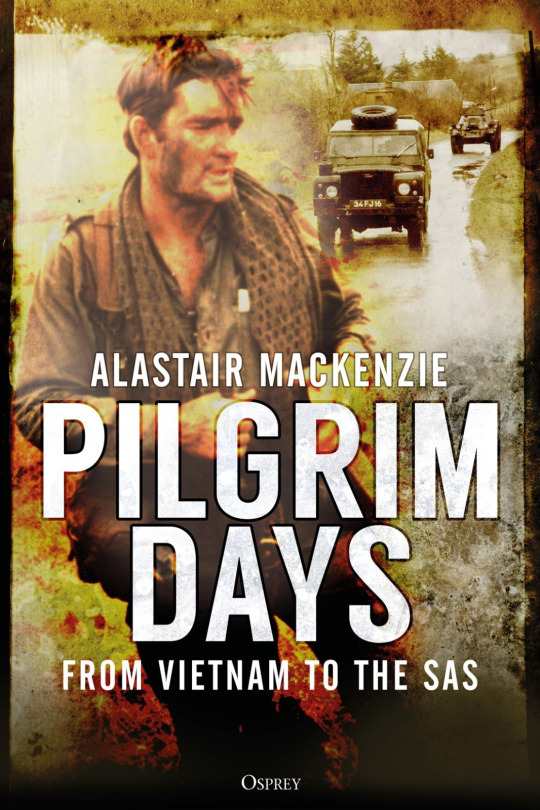
My Review: For those of us who devour military history books, especially biographies, Pilgrim Days fills a special spot on our library shelf. Mackenzie served with a multitude of military units across the globe, from the New Zealand Infantry Regiment in Vietnam to the British Paras and SAS in Northern Ireland, and the Pathfinders in the SADF fighting SWAPO in Angola. He served alongside other authors such as Dave Barr, Jan Breytenbach, and Peter McAleese and his experiences help flesh out the stories found in their books, while putting his own unique spin on them.
With his constant moving and changing of uniforms, he missed out on some major incidents like the Iranian Embassy Siege as well as the Falklands War, but his insight into the NZ experience in Vietnam, his work in Northern Ireland, his experiences in Africa, and especially his later training work in Oman and elsewhere as a private contractor are unique and definitely worth reading.
Mind you, this man has had a extremely robust life and trying to encapsulate it all in one book has made it more of an overview, where the author more often just lists and tells one or two things about each experience, instead of delving into each one in any depth. But what I found most enjoyable was his attention to the people he served with and how no matter where he ended up, he was able to slide in and soldier on.
This isn’t a fictional story about a one man army, but instead the true life of one man who served in many armies around the world, and was part of a period of time where armed conflict and instability made the cold war quite hot. With today’s global war on terrorism, and private military companies, it’s important to read Pilgrim Days and take notes of where he was, who he was with, and use it as a jumping off point to study more about the things he mentions, from South Armagh to Tim Spicer and what happened in Bouganville.
Really good book, really good read, entertaining, and I’m so glad I have it on my shelf!
Title: Pilgrim Days: From Vietnam to the SAS
Authors: Alastair MacKenzie
ISBN: 9781472833174
Tags: 21 SAS, 22 SAS, 3 Para, 32 Bn, 44 South African Parachute Brigade, Airborne, Angola, ANZAC, Ardroyne Rd, Australian Army Training Team, Belfast, Belize, China, Dhofar, Duke of Lancaster’s Own Yeomanry, Flax Street Mill, Hong Kong, Infantry, Long Tan, MPLA, Namibia, New Zealand, Northern Ireland, Northern Ireland Training and Advisory Team, Nui Dat, Oman, Operation Banner, Parabats, Paras, Phouc Tuy Province, Royal New Zealand Infantry Regiment, Royal Ulster Constabulary, SADF, SADF Pathfinders, South Africa, South African Pathfinders, South Armagh, South West Africa, Special Air Service, SpecOps, SWAPO, UNITA, Vietnam, Vung Tau
Subject: Books.Military.20th-21st Century.Africa.Angola, Books.Military.20th-21st Century.Africa.South Africa, Books.Military.20th-21st Century.Asia.Vietnam War.Infantry, Books.Military.20th-21st Century.Europe.Northern Ireland Troubles, Books.Military.20th-21st Century.Infantry.South Africa, Books.Military.20th-21st Century.Infantry.UK.British Army, Books.Military.20th-21st Century.Middle East-SWA.Oman, Books.Military.20th-21st Century.SpecOps.New Zealand.NZSAS, Books.Military.20th-21st Century.SpecOps.UK.SAS
Description: 'We are the Pilgrims, master; we shall go, Always a little further; it may be, Beyond that last blue mountain barred with snow.'
If there was ever anyone who went a little further, a little beyond, it was Alastair MacKenzie. In a career spanning 30 years, MacKenzie served uniquely with the New Zealand Army in Vietnam, the British Parachute Regiment, the British Special Air Service (SAS), the South African Defence Force's famed ParaBats, the Sultan of Oman's Special Forces and a host of private security agencies and defence contractors.
MacKenzie lived the soldier's life to the full as he journeyed 'the Golden Road to Samarkand'. This extraordinary new work from the author of Special Force: The Untold Story of 22nd Special Air Service Regiment (SAS) vividly documents, in a detail that stuns, the experience of infantry combat in Vietnam, life with the Paras, the tempo of selection for UK Special Forces, covert SAS operations in South Armagh and SAS Counter Terrorist training on the UK mainland, vehicle-mounted Pathfinder Brigade insertions into Angola and maritime counter-terrorism work in Oman.
**
About the Author
Alastair MacKenzie comes from a military family of long standing and he served as a para-trained platoon commander for 12 months with the New Zealand infantry on combat operations in South Vietnam and in the special forces of South Africa, Oman and the UK, where for four years he was troop commander in the 22nd Special Air Service Regiment. After his retirement as a full-time Army officer he enjoyed a successful commercial career with Royal Ordnance and British Aerospace before moving to consultancy roles. In civilian life he retained an involvement with the Territorial Army as an SAS officer and retired with the rank of lieutenant colonel in 2001. He obtained his PhD in politics in 2005 and is the author of works including Special Force: The Untold Story of 22nd Special Air Service Regiment (SAS) and The Sounds Soldiers' Memorial--Stories of the Fallen. He lives on the South Island of New Zealand.
#book#books#ebooks#booklr#bookblr#nonfiction#military#war#sas#special air service#sadf#south africa#northern ireland#oman#vietnam#vietnam war#new zealand#nzir#special forces
4 notes
·
View notes
Text
K.B.O. - 28 June
So here we are on our first day of co-curated learning, which is a thing I only found out existed this morning.
We’ve been over the new plan; all things going well, we’re still going to be able to get out in the field, even if it is just in the Canberra region. Cowra was mentioned but I think some of us may be a bit skittish about going out of the ACT (although if they locked down Cowra I’d be very surprised indeed.) Can’t promise anything, but I’ll lobby as hard as I can, and if things look better next week, the chance may exist of getting somewhere in regional NSW.
We proceeded on to a lecture on Everybody’s Favourite Boondoggle, the John Monash Centre at Villers-Bretonneux (or VB for short.) VB is the site of a battle (technically two battles) fought at the ‘gates of Amiens’ in 1918. The initial German assault in early April was halted by a mix of British and Australian troops, but it’s the counterattack from April 24 to 27 that people mostly remember. Two Australian and one British brigade, alongside Moroccan forces under French command and supported by tanks, pushed two German divisions from the town and stabilised the front around Amiens; one of a number of battles that marked the end of Operation Michael, the first of Ludendorff's Spring Offensives.
It was also the site of the first tank-on-tank engagement in history, so naturally there’s a metal song about it.
Flash forward to 2010 and the beginning of planning for the centenary of the First World War. Some countries were more invested in this than others - Germany spent six million dollars on the whole affair, about $2 per dead soldier. France spent about $50 per fatality, Canada about three to four hundred… and Australia spent $8889. Using enough money to buy Simpson and his donkey a business-class ticket to London, they built a big, triumphant museum under the Villers-Bretonneux memorial - literally under the graves buried there - at a cost of $100m, proclaimed Australian victory in WWI, and named it after our favourite general, John Monash.
There’s a few small problems with this. One; John Monash wasn’t at Villers-Bretonneux. General Sir Henry Rawlingson was in overall command, with the key Australian commanders being Major-General Hobbs and Brigadiers ‘Pompey’ Elliot and Glasgow. But I guess ‘The Talbot Hobbs Centre’ doesn’t quite capture the imagination.
The second problem is that, while the Second Battle of Villers-Bretonneux was important, it did not win the war. German offensives continued into June, and only ended with defeat by the French (with some Americans) at the Second Battle of the Marne. The Germans were attacking on a wide front, and the majority of the men stopping them - at great cost - were British and French. The Australians aren’t the only ones to claim their one battle stopped the Germans - I’m looking at you, US Marine Corps - but we’re probably the only ones to build a gigantic obnoxious museum about it.
The third and most notable problem is that someone decided that building a giant ‘huzzah for the Anzacs, the Manliest of Men’ with a big light-and-sound show, simulated gas and artillery attacks, faceless ‘Huns’ and immersing patrons in the killing of said ‘Huns’ under a war cemetery was somehow in good taste.
I could rant long and hard about this thing and I haven’t even seen it in the flesh. Perhaps that means I’m being unfair. But there are dead Australians and Britons in that cemetery who I feel have been treated unfairly by the cemetery. (And don’t get me started on the omission of the Moroccans, or we’ll be here all day.)
After that, we did comparative presentations on how other countries marked their centenaries; usually with somewhat more taste (Britain), a touch of awkwardness (Germany) or an exclamation of ‘oh yeah, we were in that war, weren’t we?’ (the USA.) We watched an interview with Jay Winter (an American memorial historian and Bruce’s spiritual liege) and Michael Roper (a British historian, although it is unknown if he is anybody’s spiritual liege.) There was a break in the middle of this - I went to buy lunch and bought three books, and no lunch.
I also got gifted Niall Ferguson’s The Pity of War; the jury’s still out on if I was just being used to offload a Niall Ferguson book onto but the gesture was certainly appreciated. (For those curious, the other books were The Beauty and the Sorrow by Peter Englund, A World on Fire: Britain’s Crucial Role in the American Civil War by Amanda Foreman and Hue 1968 by Mark Bowden. Hopefully I do not get them confused and end up picturing British redcoats charging machine guns in Vietnam.)
At the end of the day, we watched Peter Weir’s Gallipoli. I have opinions about this film. For the uninitiated, the movie (made in 1981 and starring a young, pre-racist Mel Gibson) follows two Western Australian blokes (in a suspiciously South Australian-looking WA, I might add) as they enlist in the 10th Light Horse, train in Egypt and eventually fight in the Gallipoli peninsula, notably in the disastrous Battle of the Nek.
On one hand, Weir is one of the best cinematographers in the world today - one just needs to look at my favourite historical movie, Master and Commander, to get an idea of just how good he is. This is an exquisitely directed film. Despite my knowledge of 1900s railway rolling stock exposing the fact that they filmed in South Australia and not Western Australia, everything looks as authentic as is possible for it to be. Gallipoli looks dead on. The last five minutes of the film might be the most powerful and devastating ever seen in a war film. I should love this film, and yet…
The characters are more caricatures, which I think is intentional but it’s also hard for me to care too much about them. There are a few standouts, like the main character’s uncle and the Light Horse major, but then there’s the three infantry guys who I honestly could not tell apart. There is a sequence of the main characters wandering around the desert which adds nothing to the film except to pad the run time - I do not feel I liked the characters more after this ordeal, in fact I think I liked them less. The sequence in which the Australians take leave in Cairo has aged like fine cheese, with the Egyptian people pretty much reduced to an orientalist stereotype (such as a ‘comic’ moment where the Australians wreck an Egyptian vendor’s shop for scamming them, only to find out at the end of the scene that they’d been in the wrong place.) The strategic context for the Battles of Lone Pine and the Nek is mostly off (it was a diversionary attack, but for the New Zealanders, not the British), and the line about the British standing around drinking tea at Suvla Bay is not only inaccurate, it’s downright insulting.
For context on that last one, there’s a quote attributed to Ellis Ashmead-Bartlett about the attack on Scimitar Hill at Suvla, where the British 11th and the long-suffering 29th Division lost 5,300 men. He describes the undergrowth around the wounded set alight by artillery; “When the fire passed on little mounds of scorched khaki alone marked the spot where another mismanaged soldier of the king had returned to Mother Earth.”
Hardly a tea party.
And yet, that last scene - and particularly the image of the bayonets rising out of the trench, the ground before them thick with the dead and wounded of the 8th Light Horse that went before them…
So yes, I have complicated feelings.
Tomorrow we’re out again on the memorial landscape of Canberra - of particular, the Jerrabomberra Wetlands. Which aren’t actually in the suburb of Jerrabomberra. It’s very strange.
#war#cw covid#cw racism#first world war#gallipoli#villers-bretonneux#german spring offensive#british army#australian army#morocco#german army#french army#first world war centenary#sir john monash#gallipoli 1981#mel gibson#battle of the nek#landing at suvla bay
2 notes
·
View notes
Photo

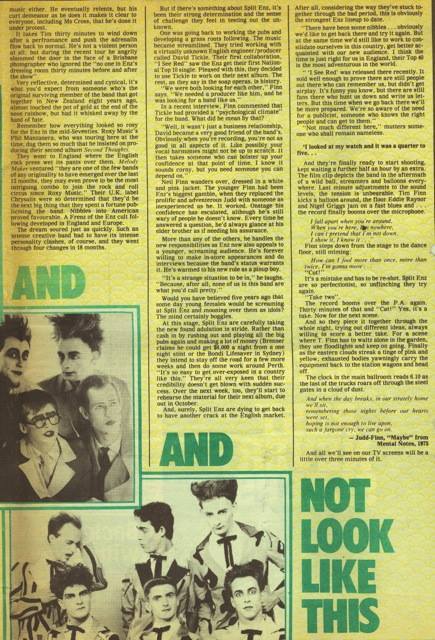

Juke magazine - 3 May 1980 front cover and article, by Christie Eliezer
TIM FINN well remembers Split Enz’s first ever Melbourne performance - they were soundly booed off stage.
It was in 1975, and Reckless Red Symons, having seen them at Sydney’s Oceanic Hotel and inevitably falling in love with their sense of theatre and originality, suggested to Skyhooks manager/record label boss Michael Gudinski that Enz play at the next major ‘Hooks gig...
“It was some time in late April (Anzac Day actually - ed) and it was at the Festival Hall, The Skyhooks were causing untold hysteria then. Gudinski, who’s only heard about our outrageous stage costumes and makeup was telling everybody that we were the second Skyhooks,” Finn said.
“We had to get up at six in the morning that day, and by the time we got into Melbourne, we only had an hour’s sleep before making our way to the hall. Consequently by the time we came on, we were very tired and irritable.
“It was such a bad introduction to Melbourne. The audience there was so into the Skyhooks that all through the show they were pulling faces, and throwing cans and cigarette butts at us.”
Finn leans back with the confidence of one who’s left his yesterdays far enough behind to be able to chuckle over them. “It was weird... no it wasn’t, it was disgusting, that’s the only way you can describe it. And we lost a lot of support from the media on that one. They saw us totally out of context, and it was a long time before a lot of them would bother about Split Enz again.”
Still, five years later and it’s over under sideways down. While the Skyhooks last single gasped for airplay. “I Got You” and True Colours are simultaneously seated at the top of the Australian charts. It’s been some years since such a double whammy has happened for an Australian band. Two weeks ago, when this interview took place, the single had sold 13,000 copied in the first three days of the week. By the time you read this “I Got You” should have sailed over the platinum mark - and you know how hard platinum singles are to get, particularly for Oz-made discs.
And the younger sisters of those dedicated Skyhooks fans who’d been so hostile to the Enz, are these days shrieking at Enz concerts, standing outside Mushroom Records’ offices hoping for a glimpse of them or pasting up pinup pictures of the country’s most recent - and unlikeliest - teen idol, Neil Finn.
Split Enz themselves have since then been drifting through different universes anyway. Only Finn, Noel Crombie and Eddie Rayner remain from that bunch of ill-dressed weird freak-outs who created a large cult following through their mixture of self indulgence, witty ideas, and acid casualty detachment. It’s true that once they managed to establish their unique concept of theatre and sense of adventure in their musical presentation, instead of having to live up to Gudinski’s absurd preconeptions, they won acclaim. But in the few times I got dragged off to one of their early concerts, kicking and shrieking all the way, they always left me stone cold bored.
“In a lot of ways, we hid behind our images,” admits Finn, who now accepts that a lot of their music in those days was self-indulgent and aimless. “It was a way we could keep our distance from the audience. I think, like most New Zealanders we’re all shy in varying degrees. But nowadays I’ve become much more confident as a performer. I can reach out to them more, to the point of sometimes actually touching them to gain a response.”
Gone too is Finn’s onstage patter, speaking in arty-farty first year university English Lit couplets. Still, there is a strong dose of bemused cynicism in his onstage yakkings, and I’m pretty sure a lot of it goes over the heads of their newer, younger audiences.
“Well, sometimes it does and sometimes it doesn’t. It’s all done for reaction. You can’t get too basic or else you become patronising.”
You can take the man out of theatre, but you can’t take the theatre out of the man?
I looked at my watch, and it was a quarter to two...
What are rock’n’roll weirdos like Split Enz doing in the lush stately grounds of the Ripponlea estate, a symbol of a bygone aristocratic/traditional era in Melbourne and now a National Trust and tourist attraction?
Making a film clip for their next single, Tim Finn’s tender ballad, “I Thought I Never”, a standout in their show.
As you crunch up the shaded, sandy driveway which curves through luxuriant flower beds, with the mansion in the distance, you’re overwhelmed by a strong sense of history, you half expect to be met by a white-helmeted pukka sahib complete with monacle and starched handlebar moustache, seated in a horse drawn buggy. What you do find is an assortment of dusty trucks and station wagons with camera crews and roadies lugging equipment out to the main ballroom - polished floors, chandeliers, gold plated mirrors and sin-soaked memories - where the main clip will be shot.
We’re told by Mushroom to turn up at 1 pm sharp to watch Enz filming and chat to the band in between breaks. Photographer Drew and myself wander in at 1:30 to find only two Enzers in sight, in a makeshift dressing room, littered with Ballroom costumes. Tim Finn is sipping champagne as he gets his face made up. Noel Crombie is busy ironing some more costumes. Tim Finn is sipping champagne as he gets his face made up. Noel Crombie is busy ironing some more costumes, typically unsmiling. Neil Finn strolls in casually thirty minutes later, followed by Eddie Rayner.
Representatives from other magazines are there as well. The Enz keep to themselves, none of this hail-felllow-well-met chummy routine. So the men of the media wander back into the sunshine and sit in an outside stone balcony, gossiping and watching the tame peacocks strut past gardeners toiling over the flower beds in the hot Indian summer afternoon.
“One of the things that makes the Enz one of the most creative bands in this country is that they’re very rarely of their image,” says TV Week’s affable Greg Noakes (he’s the one who took the stunning photograph of Cold Chisel on their Breakfast At Sweethearts cover). “At least 70% to 80% of the acts that I take pictures of don’t have a clue what they want out of the session, or how they want themselves projected.
“I’m not going to name names but there’s one top group which I did recently that just could not give a damn. Enz of course have streamlined their outrage since but that accent on the visuals is still as strong. They’ll tell you how they want to come across, and that’s the way it should be.”
While the two Finn boys are the most visual in Enz, others have their roles in the machinery. Noel Crombie for instance might be low profile and almost dispensable onstage (he plays the spoons and assorted percussive instruments) but he’s definitely Enz’s creative genius. His tremendous shyness and eccentricity manifests itself in the flamboyance of their costumes and the sheer vision of their film clips.
Even now, while it’s acknolwedged that the series of film clips coming in from overseas are the most creative in rock by far, most of them are actually covering grounds that Enz blazed in this country at least five years ago.
While Eddie Rayner has an amazing technical mind (his girlfriend Raelyn works the lights for the band), bassist Nigel Griggs is the more practical and businessminded. Drummer Malcolm Green is the most “normal” and “extrovert” as Enz get.
I looked at my watch and it was a quarter to four...
As the evening shadows inch over the stone forecourt, Tim Finn emerges from the makeup room in full costume - black tuxedo, while silk scarf, orange socks - and wanders over to where the media persons are chatting with manager Nathan Brenner, the latter dressed in a blazing yellow’n’red frilled jumpsuit... for film clip purposes, you understand.
“Did you say they’d start soon... ten minutes? Good.” Finn settles himself in a chair and botts a cigarette off somebody. “It’s different filming in a studio because you can create the atmosphere Here, in a place like this, it’s harder to control it.”
We start chatting about True Colours, it’s success, and how it’s the album Enz always wanted to make. I say it worked so well because they weren’t so consciously trying to Create Art, just damn good pop-rock music.
Finn doesn’t bat an eye. “It was a case of strealining it back to the basics really. I still like listening to this album while some of the earlier stuff was a bit... er, self indulgent. There are a lot of good radio hit tracks on it. I love listening to ‘I Got You’ when it comes on the radio, and God knows, I’ve heard it so many times already.”
One Sydney DJ suggested that after being so ahead of their time, tastes had changed enough for people to finally catch up to the Enz? What did he think of that?
“I don’t know... I hesitate to say that, because it sounds so arrogant. But having said that, in a lot of ways we were ahead of our time. For instance, the haircuts we had in ‘74 and’75 are now in vogue, although somewhat modified.”
Offstage Finn is a regular Dr. Jekyll to the energetic Mr Hyde he portrays under the spotlight. A quiet and private person, he is dedicated to the band. He hates doing interviews, but does them because they’re a necessary evil. Brenner informs him that one of the magazine wants to photograph him with New Zealand cabaret singer Tina Cross. Finn scowls because he can’t see how a photograph is going to help Enz, and he’s not not crazy about her music either. He eventually relents, but his curt demeanor as he does it makes it clear to everyone, including Ms Cross, that he’s done it under protest.
It takes Tim thirsty minutes to wind down after a performance and push the adrenalin flow back to normal. He’s not a violent person at all, but during the recent tour he angrily slammed the door in the face of a Brisbane photographer who ignored the “no one in Enz’s dressing room thirty minutes before and after the show.”
Very reflective, determined and cynical, it’s what you’d expect from someone who’s the original surviving member of the band that got together in New Zealand eight years ago, almost touched the pot of gold at the end of the huge rainbow, but had it whisked away by the hand of fate.
Remember how everything looked so rosy for the Enz in the mid-Seventies. Roxy Music’s Phil Manzanera, who was touring here at the time, dug them so much that he insisted on producing their second album Second Thoughts.
They went to England where the English rock press wet its pants over them. Melody Maker declared “they are one of the few bands of any originality to have emerged over the last 12 months, they may even prove to be the most intriguing combo to join the rock and roll circus since Roxy Music.” Their U.K. label Chrysalis were so determined that they’d be the next big thing that they spent a fortune publicising the band. Nibbles into America proved favourable. A Frenz of the Enz cult following developed in England and Europe.
The dream soured just as quickly. Such an intense creative band had to have its intense personality clashes, of course, and they went through four changes in 19 months.
But if there’s eomthing about Split Enz, it’s been their strong determination and the sense of challenge they feel in seeking out the unknown.
One was going back to working the pubs and developing a grass roots following. The music became streamlined. They tried working with a virtually unknown English engineer/produced called David Tickle. Their first collaboration, ‘I See Red’ saw the Enz get their first National Top 10 single. Pleased with this, they decided to use Tickle in work on their next album. The rest, as they sayin the soap operas, is history.
“We were both looking for each other,” Finn says. “We needed a producer like him, and he was looking for a band like us.”
In a recent interview, Finn confessed that Tickle had provided a “psychological climate” for the band. What did he mean by that?
“Well, it wasn’t just a business relationship, David became a very good friend of the band’s. Obviously when you’re recording, you’re not as good in all aspects of it. Like possibly your vocal harmonies might not be up to scratch. It then takes someone who can bolster up your confidence at that point of time. I know it sounds corny, but you need someone you can depend on.”
Neil Finn wanders over, dressed in a white and pink jacket. The younger Finn had been Enz’s biggest gamble, when they replaced the prolific and adventurous Judd with someone as inexperienced as he. It worked. Onstage his confidence has escalated, although he’s still wary of people he doesn’t know. Every time he answered a question, he’d always glance at his older brother as if needing his assurance.
More than any of the others, he handles the new responsibilities as Enz now also appeals to a younger, screaming audience. He’s forever willing to make in-store appearances and do interviews because the band’s status warrants it. He’s warmed to his new role as a pinup boy.
“It’s a strange situation to be in,” he laughs. “Because, after all, none of us in this band are what you’d call pretty.”
Would you have believed five years ago that some day young females would be screaming at Split Enz and mooning over them as idols. The mind certainly boggles.
At this stage, Split Enz are carefully taking the new found adulation in stride. Rather than cash in by rushing out and playing all the big pubs again and making a lot of money (Brimmer claims he could get $4,000 a night from a one night stint at the Bondi Lifesaver in Sydney) they intend to stay off the road for a few more weeks and then do some work around Perth.
“It’s so easy to get over-exposed in a country like this.” They’re all very keen that their credibility doesn’t get blown with sudden success. Over the next week, too, they’ll start to rehearse the material for their next album, due out in October.
And, surely, Split Enz are dying to get back to have another crack at the English market. After all, considering the way they’ve stuck together through the bad period, this is obviously the strongest Enz lineup to date.
“There have been some nibbles... obviously we’d like to get back there and try it again. But at the same time we’d still like to work to consolidate ourselves in this country, get better acquainted with our new audience. I think the time is just right for us in England, their Top 40 is the most adventurous in the world.
“‘I See Red’ was released there recently. It sold well enough to prove there are still people out there who can remember us, but didn’t get airplay. It’s funny you know, but there are still fans there who hunt us down and write us letters. But this time when we go back there we’ll be more prepared. We’re so aware of the need for a publicist, someone who knows the right people and can get to them.”
“Not much different here.” mutters someone who shall remain nameless.
‘I looked at my watch and it was a quarter to five...
And they’re finally ready to start shooting, kept waiting a further half an hour by an extra. The film clip depicts the band in the aftermath of a wild ball, streamers and balloons everywhere. Last minute adjustments to the sound levels, the tension is unbearable. Tim Finn kicks a balloon around the floor. Eddie Rayner and Nigel Griggs jam on a fast blues and the record finally booms over the microphone.
I fall apart when you’re around,
When you’re here, I’m nowhere,
I can’t pretend that I’m not down,
I show it, I know it...”
Finn steps down from the stage to the dance floor, still miming:
I’ve been a fool more than once, more than twice. I’m gonna move
“Cut!”
It’s a mistake and has to be re-shot. Split Enz are so perfectionist, so unflinching they try again.
“Take two.”
The record booms over the P.A. again. Thirty minutes of that and “Cut!” Yes, it’s a take. Now for the next scene.
And so they piece it together through the whole night, trying out different ideas, always willing to score a better take. For a scene where T. Finn has to waltz alone in the garden, they use floodlights and keep on going. Finally as the eastern clouds streak a tinge of pink and yellow, exhausted bodies yawningly carry the equipment back to the station wagons and head off.
The clock in the main mallroom read 6.10 as the last of the trucks roars off through the steel gates in a cloud of dust.
And when the day breaks in our stately home we'll sit
Remembering those nights before our hearts were set
Hoping is not enough to live upon
With such a far far cry I can't go wrong
- Judd-Finn, “Maybe” from Mental Notes, 1975
And all we’ll see on our TV screens will be a little over three minutes of it.
4 notes
·
View notes
Text
Easter adventures: Part 1
Our blog posts are like buses - none for ages and then two will come together! It’s been an adventure filled few weeks so apologies for the delay!
Since our last update I have finished my 6 months of oncology. It was a bittersweet departure – it was the longest I’ve ever worked on one job so had developed some lovely relationships and was sad to leave such a great team of skilled and fantastic humans. It was an emotionally challenging job at times and I think we all really helped each other through that. However, it was time for pastures new and other challenges! Before that though, Tom and I both had some time off to enjoy!
For Easter Sunday, we had planned a roast lunch together at home between my cathedral commitments but in a last minute change of events (last minute being at 11.30 after the morning service) with the rest of the my choir friends in a dilemma of where to go out for lunch, I ended up (after a quick call home to Tom) inviting them all over for lunch at ours! We all went via the glorious Harris Farm market en route and each picked up some hot roast chickens, salads, drinks and cheese and it ended up being the easiest Easter lunch ever and was very lovely to spend time with them all!
First thing on the Monday, we packed up the car and headed north up to Coffs Harbour; a fairly long drive made pain-free with lots of podcasts and digestive biscuits! When we arrived we did a lovely walk out to Muttonbird Island and saw some of the last remaining very fluffy Wedge-tailed Shearwater chicks which the island is known for. There was an organisation there who had put up posters about what to do if you found a chick in the city – sadly the chicks would mistake the city lights for the moon and fly in the wrong direction when they were ready to leave, so there were volunteers who collected the lost and returned them back to the island in the evening for another go!
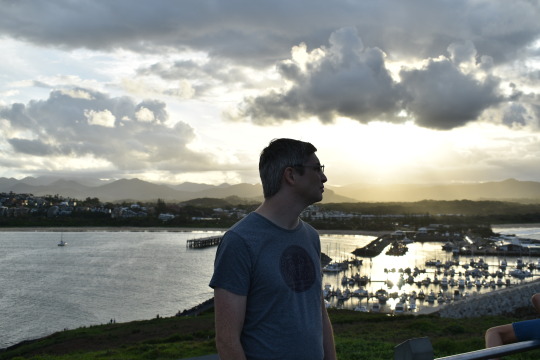
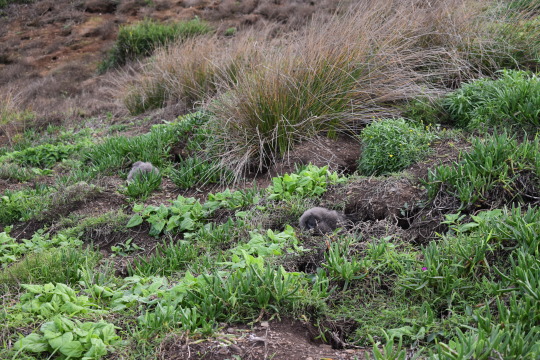
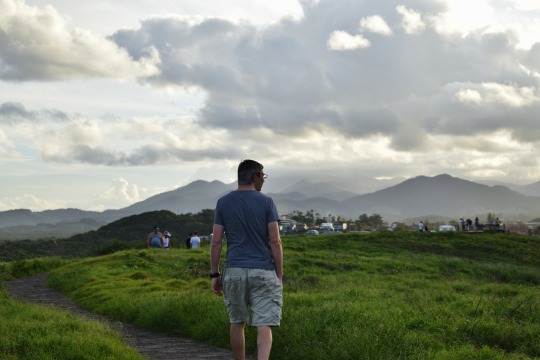
Day 2:
Breakfast on the beach in Coffs followed by quick detour to see the famous ‘Big Banana’! We had decided to drive inland a little along the Waterfall Way to Dorrigo National Park – a very lush rainforest in the clouds and much colder than Coffs. As we walked out to a lookout point we saw a python in the tree right next to the walkway; our first snake encounter since arriving and thankfully an uneventful one! We did a beautiful walk through really lush rainforest, with eerie mist between the trees! The walk was steep downhill to a waterfall – now unfortunately we have been spoiled by the enormous grandiose waterfalls of Iceland and so on arrival Tom was fairly underwhelmed to have walked all this way (with a steep uphill climb back imminent) for a fairly small waterfall! Still, it was a beautiful walk and certainly the most ‘rainforest-y rainforest’ we’ve seen since arriving here! Was then a short drive down to South West Rocks for night number 2!


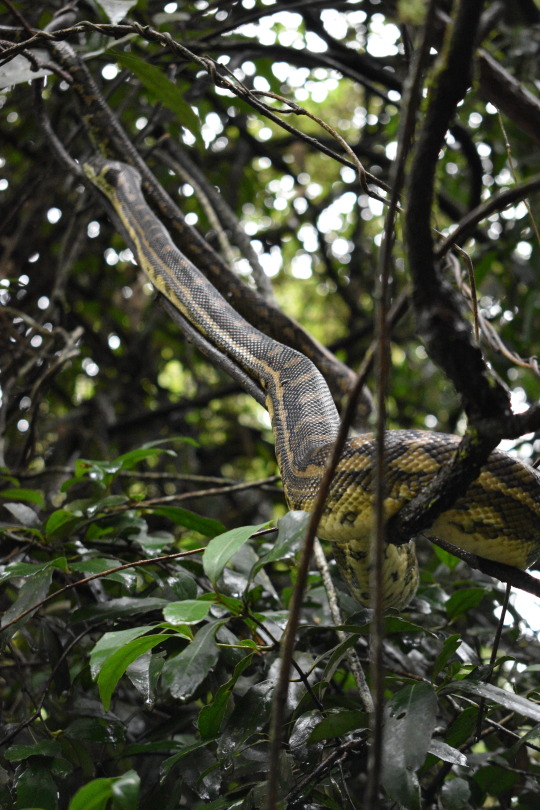
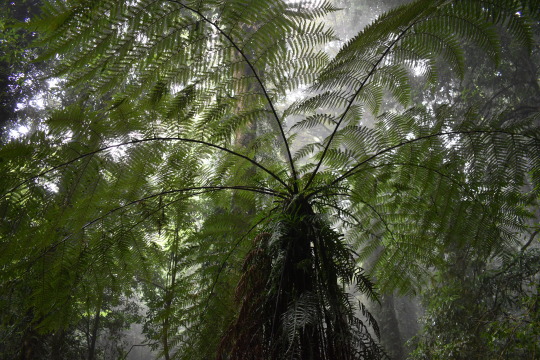



Day 3: An early start to go diving at Fish Rock Cave! It was to be a 40 minute boat ride out, and two dives with an hour on the boat in between. Since our recent boat dives have ended up with both of us bringing up our breakfast, we had come armed with sea sickness tablets but thankfully the wind and swell were much more manageable than previously! We’d also heard news that divers had seen a whale shark there 2 days prior so we were eager to get in the water!

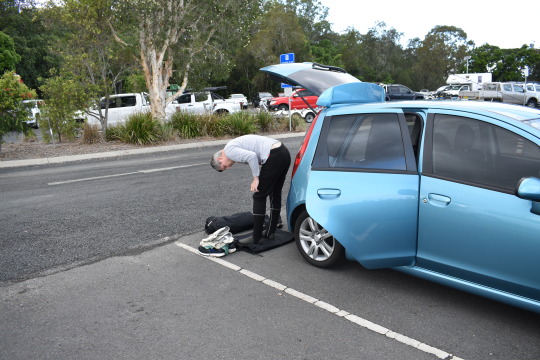
(At this point I probably advise both our mothers to close their eyes and scroll down a bit to Day 4).
The first dive was amongst 7 or 8 grey nurse sharks, about 30 wobbygongs and lots of fish. I wasn’t sure what my reaction would be to the sharks but it was absolutely mesmerizing to look down and watch them swimming up and down between the rocks so gracefully! We even saw a guitar shark up close which the dive club not seen for a while. Managed to find myself a lost shark tooth on the bottom to keep as a memo!
Our GoPro decided not to work on the first dive so this is obviously not my photo but we were on top of the rock crevice seen here, looking down on a scene not dissimilar!

The surface interval was spent refuelling with a cup of tea and some biscuits. Tom had a few issues with getting the dive centre to give him the weight he needed which led to a bit of an uncomfortable and floaty first dive so we tried to add a bit more for dive 2. This one was Fish Rock Cave, which is Australia’s only true ocean cave and was about 125 metres long. It was pitch black in there so torches definitely needed and for about half the length was space for single-file only, including a vertical ‘chimney’ to swim up! We saw a snoozing turtle, lots wobbygongs, crayfish, eels and again a whole host of different fish! One of my favourite parts was when the cave started to open out and there was just this bright blue glow ahead filled with the profiles of the marine life swimming around! We were very lucky with the conditions that day and the visibility was about 15 metres, which made the dives even more fantastic! Tom has put together some footage from the second dive in the video below to give you an idea!
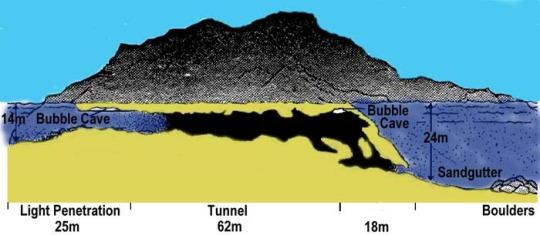
youtube
Once we’d changed, fed and watered ourselves, we made a quick trip to Trial Gaol, one of the prisons used for deported convicts in the 1800s - a fairly thought provoking visit made slightly more light-hearted by lots of kangaroos hopping around the place!
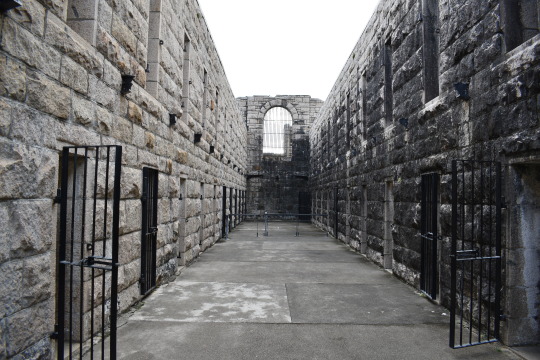
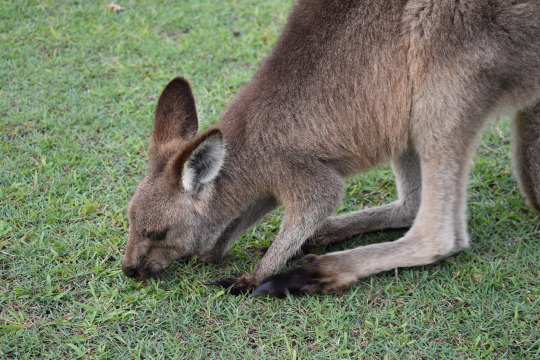

We then drove down to Port Macquarie for the last part of our short trip! We were staying just outside of Port in a slightly more rural place called Sancrox. The night sky was unbelievably clear so it was an excuse to attempt some long exposure shots of the stars which I don’t think came out too badly!

Day 4: ANZAC day. We didn’t quite make it to the 5am dawn service after post-dive exhaustion but we made our way into town for the 10am procession and service in the town square by the cenotaph. The procession involved cadets, marching bands, veterans but also schools, scouts and girl guides. We had a good position right next to the memorial and it was an expectedly moving ceremony with a playing of The Last Post and a young boy singing the New Zealand and Australian National Anthems.

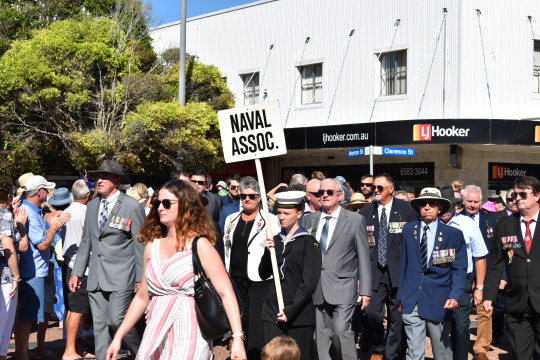

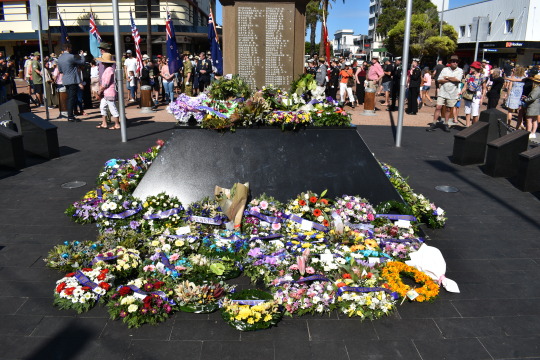
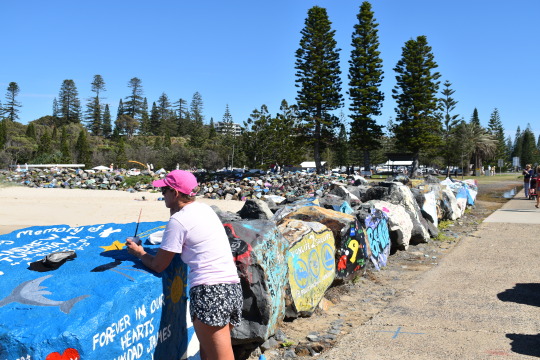
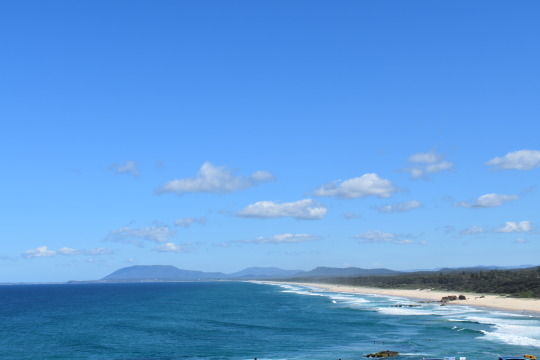
We did a couple of short walks along the coastline before starting the drive back to Newcastle in time for me to get things washed and packed before heading off on my solo adventure the next day! More of that to come...!
1 note
·
View note
Note
Do you have any favorite books about the ANZACs/AIF on the Western Front?
Oh man yes. So many. So in no particular order:
General:
Broken Nation - Joan Beaumont - The best single volume history of Australia at war. Covers the AIF and its campaigns, the home front and modern memory of particular events. If you read any book from this list, read this one.
The Broken Years - Bill Gammage. The published version of Gammage’s PhD thesis, this is a superb book that tells the story of the AIF mostly through diary entries and letters of soldiers. For an understanding of life lived in the AIF during the war nothing beats it.
The Great War - Les Carlyon. A tome of a book, but a very engagingly written account of the AIF on the Western Front. Features a lot of down in the trenches detail about the battles from diary and letter accounts.
Australia and the Empire:
The Anzac Illusion - Eric Andrews. A fantastic look at the AIF and how it fit into the broader British Army during the war. Looks at some of the myths about Australian superiority and how similar Australians of 1914-18 were to their British counterparts.
The Anzac Experience - Chris Pugsley. Despite the name actually covers Australia, New Zealand and Canada, comparing the commanders and formations of each Dominion and seeing how their wartime experiences were both similar and different in all sorts of interesting ways.
Anzac and Empire - John Connor. Technically a biography of wartime Australian Defence Minister George Foster Pearce, this book mostly covers his work during the war. Fantastic look at the political side of the AIF and how it had to juggle public and political sentiment at home with the needs of the military and the British government.
Operational:
To Win the Battle & The War with Germany - Both by Rob Stevenson. To Win the Battle is an in depth study of the 1st Australian Division during the war and shows how an Australian formation lived, worked and fought during the war and what it took to produce a successful fighting formation.
The War with Germany provides great coverage of the Australian campaigns on the Western Front, explaining the fighting they took part in as well. Covers how the battles were fought and where they fit into the larger picture.
Attack on the Somme & The Battle of Pozieres - Meleah Hampton. These are two deep operational analyses of Australian battles of 1916. Full of great research they’re probably not for the casual reader, but if you want to know how operations in 1916 were imagined, planned and carried out, these are where to look.
Monash as Military Commander - Peter Pedersen. A great study of Monash the general that clearly lays out his strengths and weaknesses from his time at Gallipoli through the Hundred Days. Puts Monash firmly in his place as a good, but not genius, general who used skills gained as a civilian to effective use on the Western Front.
Biographies:
Pompey Elliot - Ross McMullin. Another tome of a book but a truly great biography of one of the most colourful characters of the AIF. A charismatic leader and fiercely Australian, Elliot split opinion both in the AIF and the British military. A smart commander he was passed over for promotion due to his explosive temper and clashes with his superiors. Details how deeply affected he was by the events of Fromelles and how his life ended in suicide after the war.
John Monash - Geoffrey Serle. The biography of Monash. There’s been a spate of them in the last decade and none come close to this one.
The Soul of Anzac: William Birdwood - John Dermot Millar. It’s tough to understand the AIF and it’s peculiar brand of Australian Britishness, but it helps to know the man who led the AIF.
Misc:
Bad Characters - Peter Stanley. Looks at the dark side of the men of the AIF looking at topics of criminality, discipline, sex and disease and the like. A good counter to a lot of the Anzac mythology.
Anzac’s Dirty Dozen - Craig Stockings. Despite the terrible name this is a very good look at some of the most enduring myths about Australia during the war and shows that the reality is much more interesting.
What’s Wrong With Anzac? - Marilyn Lake, Henry Reynolds, Joy Damousi, Mark Mckenna. Not strictly about the war itself but a good look at where we are now with commemoration and the raising of Anzac to a secular religion in Australia. Not actually an attack on Australian history, but more on the culture and politics that have twisted it.
#this turned out to be a lot longer than i thought it was going to be#and full disclosure#john connor is my phd supervisor#send more requests#this was good for my brain
21 notes
·
View notes
Text
Southern Hemisphere Sabbat Dates
Wiccan Holidays in the Southern Hemisphere. What is the Wheel of the Year, or Wiccan holidays, for those in the Southern Hemisphere? It gets a little tricky since Wicca was created in the Northern Hemisphere. Since it’s a nature religion, an Earth religion, this makes a big difference.
✨ Lammas: 2nd February
Lammas is the “cross-quarter” day marking the first harvest of early grain, where the first loaf of the bread from the harvest is broken and shared in the name of the Goddess. All crops associated with grain and of the season are sacred to this time. Much festivity is coincident with Lammas in Australia, with Australia Day being marked on January 26. It is a time to reflect on the successes of the year and to reward yourself for jobs well done. Lammas magic can be magic of facing up to change. The God gives his energy to the crops to ensure life while the Goddess, as Mother, prepares to transform into her aspect as the Crone. The God loses his strength as the days grow shorter.
✨ Manbon: 20th - 23rd March (Autumn Equinox)
Mabon is a balancing point in the light and dark of the year, the day when the sun has equal hours in and out of the sky. It is also the second harvest. At this time food is prepared for storage, jams and pickles are made, and fruits are candied and preserved for the coming winter. Pagans celebrate this as a rite of Thanksgiving, a celebration of harvest abundance, an appreciation of hearth, home, and family. It is a time to reflect on what it means to be a Witch and re-affirm your commitment to the Craft. This is the time when the Goddess is mourning the God even though she carries him within her, to be born again at Yule.
✨ Samhain: 1st May
The Pagan year begins (and ends) with Samhain. It is a time of reflection, of looking back over the last year. This is the time when the boundary is thinnest between the worlds of living and dead; the powers of divination, the Sight, and supernatural communication are strengthened on Samhain night, and it is considered a powerful but dangerous time to communicate with lost loved ones. Pagans celebrate Samhain as an acknowledgment that without death, there can be no rebirth. At Samhain, the darkness increases and the Goddess reigns in her powerful aspect of the Crone. The God passes into the underworld to become reborn of the Goddess again at Yule. It is a time to honour those who have gone before us and it is a poignant co-incidence that Australia and New Zealand’s day of Remembrance for their fallen in war, ANZAC Day on April 25, should be so close to the southern Samhain.
✨ Yule: 20th - 23rd June
Winter solstice or Yule is the shortest day, and also the longest night of the year. It marks the return of the Sun’s warmth and light, and the promise once again of a productive Earth. Pagans celebrate these aspects with candles, fire, greenery and feasting. At this time, Yule logs are burned. The Yule log must traditionally be the root of a hardwood tree, and in Australia mallee roots are ideal for this purpose, as are Tasmanian oaks and all types of Eucalyptus. The Yule log is burned down until nothing but a small piece remains, which is saved and kept to be used as a lighter for the following year’s Yule fire. A Yule tree is placed within the traditional Wiccan home, with a pentagram (five pointed star) at the top, symbolizing the five elements. Presents are exchanged and many Witches stay up all night to welcome the sun. This is symbolic of the Goddess giving birth to the God and then resting after her ordeal.
✨ Imbolc: 1st August
Imbolc is the time of the beginning of beginnings, the time to consider carefully what you will do with the year stretching before you. Imbolc brings the awakening of the life force when the first green shoots of bulbs appear. Life is stirring again and this marks the Goddess recovering after giving birth while the newborn God is depicted as a small child nursing from his mother. The God is growing, spreading sunshine all around causing things to grow. It is a time to honour the feminine and get ready for spring. At lmbolc, the Australian forests are bright with the colour yellow, the Acacia trees coming into full flower.
✨ Ostara: 20th - 23rd September (Spring/Vernal Equinox)
The Equinoxes are the balancing points in the cycle of the seasons, when the day and night are of equal length, reminding us of the harmony of the whole. Buds of flowers and leaf, all manner of eggs and just-born life are celebrated in decorations and imagery as Pagans rejoice in the Earth’s reawakening. The urge of spring is to do, create and bring in the new. Here light overcomes darkness with lengthening days bringing the magic of new growth. Ostara is associated with childhood and new life, and the God and Goddess are perceived as children, personifying youth and innocence before their entry into adulthood. The Goddess, as the Maiden, covers the earth with flowers and love while the God grows to maturity. This is a time to honour the masculine and to celebrate everything that is great about being alive.
✨ Beltane: 31st October
Beltane, the beginning of the summer months is at the November cross-quarter. This is the festival of the Great Rite - of sexual union between Goddess and God. Beltane is the spring fertility festival and there is feasting and celebration - a great festival for lovers! Beltane is the most popular time for Witches to be handfasted. This is the time when the brilliant red flowers of the Flame Trees highlight Australian forests and gardens.
✨ Litha: 20th - 23rd December (Summer Solstice)
This is the longest day of the year, and a time of joy and strength for the light. It is a time when the powers of nature are at their fullest. In the past this was often marked with bonfires and celebrants staying awake through the short night. To leap over the bonfire was to assure a good crop; some said the grain would grow as tall as the leapers could jump. Due to fire restrictions in Australia throughout summer, celebrations for this Sabbat tend to be quite different from those throughout the rest of the year. No candles can be lit, no cauldrons burned, and no open flames are allowed outside throughout much of the country. Litha falls in the dry stifling heat of summer in the southern part of our land, but in the north, Litha falls in the hot, wet season, and represents fruitfulness. In Australia the Sturt Desert Pea is a sacred flower of this time. This is a time of ascendancy of the God, at his most powerful now, while the burgeoning Goddess brings forth the bounty of the Earth.
#wicca#witch#witches of tumblr#wiccan#wheel of the year#southern hemisphere#australia#new zealand#mine#my posts#lammas#manbon#samhain#yule#imbolc#ostara#beltane#litha#earth#religion#holiday#halloween#christmas#pagan#paginism#spell#pagan wicca#sabbat#sabbats#witchcraft
212 notes
·
View notes
Text
World War I (Part 71): The Black Day of the German Army
It was a morning near the end of May 1918, and the German army was on the banks of the River Marne, barely 80km from Paris – this was where they'd been 3.5yrs earlier. They were exhausted, and while moving southwards some of the soldiers had made themselves sick from overeating food taken from enemy stores. But since the start of their Chemin des Dames offensive, they'd advanced constantly to arrive at this point. They'd wrecked 7 British & French divisions, taken 50,000 prisoners, and advanced about 48km. The way ahead looked clear: the Entente troops retreating before them were thin on the ground, had hardly any artillery, and were unable to find a place to stop & turn to fight.
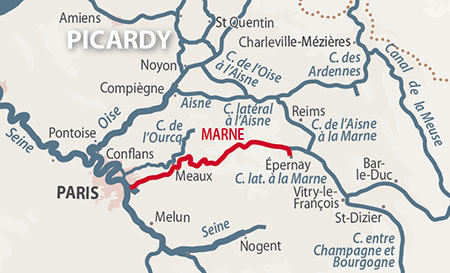
But it was an empty triumph all the same. The Germans' enormous salient was growing longer and wider, but the base of the salient was far too narrow – in fact, it was in danger of becoming smaller. It the French held onto Reims and took Soissons, and closed the salient, then these troops would become trapped.
And the Allies (the Americans were now in the war) didn't really understand how vulnerable the Germans were, either. Germany had taken Soissons and seemed about to take Reims, they were starting to cross the Marne, and seemed unstoppable. Commanders began to panic.
At the eastern end of the front (south of St. Mihiel), General Noël de Castelnau began working out a plan for withdrawing to the west, thus abandoning the fortresses that had made his sector almost impregnable for so long.
To the north, Haig's staff were bringing out plans for evacuation back to England. Foch suggested that Clemenceau should prepare for the government to leave Paris (100,000's of citizens were fleeing the city) and talked of fighting all the way southwards to the Pyrenées.
Franchet d'Esperey ordered the Fifth Army to give up Reims. Lloyd George had returned from Versailles, and finally agreed to give Foch more troops from home. They were desperately needed – Haig was disbanding 145 battalions to replenish the other ones.
Only Pétain was calm. He was sure that the Germans had overextended themselves to a fatal degree, and if the Allies just held on, their defeat was certain.
And then the situation began to turn around. Two of Pershing's divisions had been ordered to converge where the Germans were crossing the Marne, and they linked up with French units & met the Germans at Château-Thierry. This was the Americans' first major engagement, and it forced the Germans to stop.

The commander at Reims ignored d'Esperey's orders to abandon the city, and stopped the Germans there, too. The Germans pulled themselves together for another assault on Reims, but they didn't have Brüchmuller's artillery, and failed miserably.
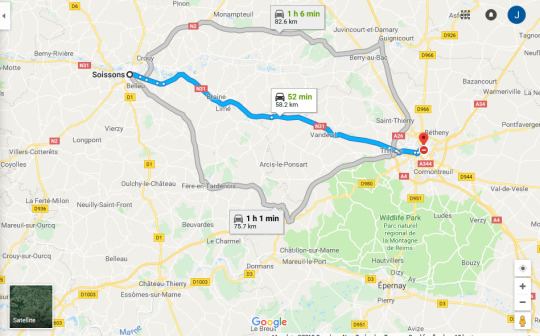
Reims is the red pointer on the right.
So Ludendorff turned to the next phase of his plan – attacking at the River Matz, west of Soissons. The objective was to broaden the salient's base at the western end, pushing the Allies back far enough that they couldn't threaten the one railway line that was supplying the German troops on the Marne. The attack would begin on June 9th, with Oskar von Hutier's army leading it. Secrecy was impossible, as everything had to be done so quickly.
As preparations were going on, American Marines launched an attack at Belleau Wood, to block one of the Germans' approaches to Paris. They advanced shoulder-to-shoulder like the Entente troops had at the Somme, but their morale was high and they had so many troops that they kept advancing slowly. After three weeks and many casualties, they would secure the wood, and have killed many German troops that Ludendorff couldn't afford to lose.
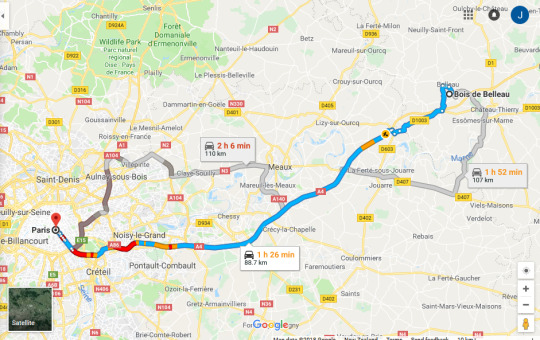
Battle of Matz
In fact, Hutier's preparations at the Matz were so rushed and obvious that the French began to suspect that it was merely a ruse, to distract them from something else being prepared elsewhere. German deserters even told the French the exact times of the bombardments and infantry advance.
When the German attack began, it started with a Brüchmuller barrage and forward rush by experienced troops, like the beginning of Operation Michael. It was a complete success, because the commander of the defenders was a follower of Foch, and ignored Pétain's defence instructions, putting his main force on/near the front line. Of course, the German artillery just wrecked it. Hutier's troops advanced about 9.5km that day, demolishing 3 French divisions and taking 8,000 prisoners.
But then on June 11th, the French suddenly counterattacked west of Soissons, directed by Charles Mangin, nicknamed “the Butcher”. Throughout the war he had been obsessed with feriously attacking and never defending, and he'd been alternately praised and condemned for it, even removed from command for taking things too far. Foch had put him in back in command of a corps, and this time he was the right man for the job.
The French were concealed by fog, and they attacked eastwards, catching Hutier's troops on open ground without any prepared defences. They threw the Germans back with such force that Ludendorff immediately called off the Matz operation.
After that, there was a month of relative quiet. Both Germany and France were preparing new attacks. Also during this period, the first cases of Spanish influenza were appearing. While all the armies were affected, the Germans had it the worst because of chronic malnutrition. All along the front line, thousands of men became too sick for duty – as many as 2,000 per German division. In the end, 186,000 German soldiers and 400,000 German civilians would die of the disease.
Battle of Hamel
The Battle of Hamel was on July 4th. It was one of the most remarkable operations of the war, and relatively bloodless. It took place near Amiens, in order to clear away the German threat to the city. Lieutenant-General John Monash planned and executed it. In April, he'd been knighted by King George, promoted to his current rank, and appointed to be the first non-English commander o the BEF's Australia-New Zealand corps.
Monash grew up in the Australian outback, and was the son of Jewish shopkeeper parents who had emigrated from Prussia. The Monasch (original spelling) family home wasn't far from Ludendorff's birthplace.
Monash had gained degrees in engineering, liberal arts and the law; he was an accomplished musician & linguist; and founded a construction firm that directed bridge & railroad construction all across Australia. In Australia's tiny army he became a reserve officer; designed a breech-loading cannon; and became a popular lecturer on tactics and military strategy.
At the start of the war, he was given command of one of Australia's first brigades; he spent 1915 at Gallipoli, where his brigade went ashore as part of the first invasion, and stayed until the end. At Messines Ridge in 1917, he contributed significantly to Plumer's success; at Third Ypres and Passchendaele he commanded a division as a Major General.
Powerful Australians had tried to keep Monash out of the war; later in Europe, people tried to obstruct his advancement. He was an amateur soldier, a colonial, Jewish, and his parents were from Germany. In 1918, his being given a third star and command of 200,000 Anzacs raised eyebrows. He only continued to succeed & advance because every general who served with him came to admire & defend him, and the king came to respect him.
Monash was an organizational genius and had plenty of experience in the management of huge projects. At Hamel, he integrated all the new machinery of war in a way that no-one else had managed to do – machine-guns, artillery, tanks and aircraft. With his plan of attack, the troops took only 93min to reach all their objectives, capturing 1000's of enemy soldiers, and taking only light casualties. They secured Amiens and opened a way for further Allied offensives.
Basil Liddell Hart said that Monash “had probably the greatest capacity for command in modern war among all who held command.” He had abandoned the old-school dash and flair of the British & French professionals, and “fulfilled the idea that gradually developed in the war – that the scale and nature of operations required a 'big business' type of commander, a great constructing and organizing brain.”
Hamel has been called the first truly modern battle, and for good reason. Later British operations used it as a model. A brochure describing Monash's tactics was distributed to every BEF officer. And it set the stage for the Anzacs to serve as Britain's shock troops for much of the rest of the war (often operating jointly with the Canadians).
Second Battle of the Marne
This began on July 15th, when 49 divisions of Crown Prince Wilhelm's army attacked Reims yet again. It was supposed to be the climax of the Chemin des Dames offensive, open a second railway line into the Marne salient, and prepare the way for the offensive in Flanders (which was to begin 5 days later).
But unfortunately for the Germans, Pétain had finally won the commander of the French Fourth Army over to his way of thinking, and an effective defence system was put into place east of Reims – the Germans got nowhere on that side of the city. The west side was still following Foch's beliefs, and the Germans penetrated deeply and quickly, despite not having the advantage of surprise at all. But by the second day, it was obvious that the eastern failure had left the western German troops dangerously exposed as they advanced.
Ludendorff called off the attack, and left to meet with Crown Prince Rupprecht at Tournai, in the north. It was time to finalize the preparations for Flanders, and Brüchmuller's guns were already being transported by train. But it was not going to be as he'd envisioned.
It was four months since the original plan, and the Entente were in a much better position in Flanders than they had been. Haig had finally got his 100,000 labourers fully employed, building new fortifications and laying out miles of wire, thus greatly improving the defences. They still had powerful reserves nearby, because Foch had refused to release them for the Marne.
The attack had to go ahead anyway, because Flanders was the last card left in Ludendorff's hand, and he was determined to play it. But while he and the CP were deep in discussion, news arrived. The Germans south & west of Soissons had been hit by a huge French offensive. They were in retreat.
Mangin led this attack, and again it had come out of the forest west of the Chemin des Dames. 23 divisions (including 4 American divisions), with 500 tanks in front of them, had attacked eastwards, with the goal of retaking Soissons and sealing off the German salient.
By 9:30am (while Ludendorff was hurrying southwards by train), the Americans & French had overrun three German lines. The American First & Second Divisions were at the centre of the attacking force.
A soldier would later recall, “Machine guns raved everywhere; there was a crackling din of rifles, and the coughing roar of hand grenades. Company and platoon commanders lost control – their men were committed to the fight – and so thick was the going that anything like formation was impossible. It was every man for himself, an irregular, broken line, clawing through the tangles, climbing over fallen trees, plunging heavily into Boche rifle pits. Here and there a well-fought Maxim gun held its front until somebody – officer, non-com, or private – gained a few men together and, crawling to left or right, gained a flank and silenced it. And some guns were silenced by blind, furious rushes that left a trail of writhing khaki figures, but always carried two ore three frenzied Marines with bayonets into the emplacement; from whence would come shooting and screaming and other clotted unpleasant sounds, and then silence.”
German reserves eventually arrived, and stopped the Entente advance. Their field artillery, firing at point-blank range, destroyed most of the tanks. By the end of the day, the Germans had managed to put together a defensive line about 8km back from where they'd started. But they'd lost 15,000 men as POWs, and 400 guns.
While they'd stopped Mangin from taking Soissons, he was still a major threat. There was no hope of taking Reims, and Soissons was in increasing danger, and the Marne salient was simply too vulnerable to keep. Ludendorff had to postpone Flanders indefinitely to deal with the situation.
He sent an army to defend Soissons, and later on in the day he met up with Kaiser Wilhelm, and told him that (as in 1914) they had to withdraw from the Marne. Preparations were begun for getting the troops out, and as many guns & supplies as possible, up through Soissons to safety.
Back in March, the Germans had had 300,000 more troops than the Allies. But between the start of Operation Michael and the end of July, they'd lost a million troops (killed, wounded or POW), many of them the young, skilled storm troops. Britain & France had lost half a million men each, and the French had almost no replacement.
But now, over 250,000 Americans were arriving in France every month; the Allies now had 200,000 more troops than Germany, and the difference was increasing every day. The Allies did have fewer divisions, but the German divisions were in terrible shape – over 100 were classified as unfit for use on the offensive.
The men who had fought their way across the Marne were now being destroyed by the Entente armies, and the only thing left was to escape back out of the salient before they were cut off. One German soldier later recalled, “Midnight. Time to leave, to escape the annihilating fire at daybreak. The Sixth Company remains behind the cover the retreat. The first group starts off, ten minutes later the second, and then after a few rifle salvoes the rest. We leave the ruined glade, climbing over the numerous shell holes in the underbrush. Here and there rises a sandy mound in which a rifle is stuck, a steel helmet over its butt. There they lie buried, those who would never come back from the battle of the Marne...Along the road back to Romigny the column passes rattling artillery, the riders in the blowing rain bent over in their saddles, the cannoneers hanging on the limbers of the guns. Between slouch the dispersed fragments of infantry, the remnants of companies, guns slung round necks, tarpaulins over heads against the rain, the knapsacks underneath bulging with the effect of a line of comic hunchbacks...The long lines of infantry file in the grey morning out of the woods, over the open field, without haste...Behind us thunder the engineers' demolitions. The engineers soon come running down the slope, followed by the infantry rearguard...Only our dead remain behind.”
The Flanders offensive, the whole point of Operation Michael and everything that had come afterwards, was long overdue, and not even all that likely to take place. Ludendorff was in a terrible state – self-isolated and distracted, easily enraged, and on the edge of collapse. And he worried about what would happen when the German public realized how great his failure was.
On Foch's orders, Allied troops were attacking all around the edges of the Marne salient. The salient was shrinking quickly as the Germans hurried to make their escape. On July 24th, Foch, Pétain, Haig and Pershing met and agreed (with some difficulty) on a co-ordinated series of major offensives.
Haig would attack eastward our of Amiens (this was possible because of Hamel's success). Pershing was demanding that the divisions that had been scattered to help deal with the German offensives be returned to his section; he would advance on the old St. Mihiel salient south of Verdun.
For both of these offensives, the purpose was to capture railway lines that the Germans needed, and that would help the Allies greatly with their own supplies. The fact that the Allies were now able to make such large-scale plans showed that they had now completely taken the initiative, and Ludendorff could only react.
The next day, July 25th, Ludendorff made a final attempt to encircle Reims, and yet again it was a failure – his forces simply weren't strong enough for an offensive punch.
The retreat towards Soissons continued in an orderly fashion, even though the Allies were still attacking from three directions. The Germans launched counterattacks to stop them getting too close.
When Pétain's forces attacked along the Marne, they encountered a thin – but tenacious – rear guard, and made little headway. But this attack drew in more German troops, thus preparing the way for the next French blow.
This came on August 1st. Mangin's troops advanced eastwards, as they'd agreed, in another attempt to take Soissons, and they nearly succeeded. The combined French-American force pushed the Germans back 8km in one day, and captured the high ground south of the Vesle river (which Reims stands on), and from there they could train their guns on Soissons. But their attack had come just a bit too late – the Germans slipped out of the salient and took up new positions north of its base, giving up Soissons with barely a shot fired. The French followed, moving in behind them.
Like 1914, the Germans had reached the Marne and crossed it, been unable to sustain the advance, been forced to retreat, and had stabilized themselves across the Aisne. But the German army was reduced and battered; it faced stronger enemies than it had in 1914; and there were fewer resources with which to establish a defensive line. But Ludendorff could not see this. Even as late as August 2nd, he spoke of an imminent return to the offensive, in a communication to his army commanders. And that would be impossible.
Third Battle of Amiens
August 8th was the first day of the Third Battle of Amiens, and what was known afterwards as the Black Day of the German Army (as Ludendorff named it). The British attacked east of Amiens under Monash, whose corps had become part of a new army created to replace Gough's broke Fifth Army. The attack had been organized hurriedly, in order to prevent the Germans from gaining any opportunity to regroup after their escape from the Marne.
It went perfectly, lead by 600 tanks and Monash's Anzac troops, taking the Germans by surprise and scattering them in all directions. Morale and organization collapsed quickly. By 10:30am the Anzacs had advanced about 9.5km, and by noon it was about 19km.
The Germans were refusing to respond to orders, or even attempt to stop and fight. Reinforcements came up from the rear, and they were taunted as “scabs” and “strikebreakers”. The Germans lost over 650 officers and 26,000 troops on August 8th alone, with 2/3 of them surrendering willingly and eagerly, often in large, well-armed groups.
But Marwitz managed to bring the situation under control, sealing the hole in his line with reserves and organizing a counterattack that pushed the British back to only a few miles forward of where they'd started from. And the Allied tanks were not invincible. Many would break down after an hour or two of action; some overturned or got stuck in the mud; they could also be broken open with heavy machine-gun fire, or blown apart by field artillery.
Also, the British & French infantry were inexperienced on the offensive, and this helped the Germans. August 8th showed that the Germans were in a terrible state, but also that finishing them would likely be costly and slow.
With Foch in command, the Allies were constantly attacking or in preparation for attacking. The Germans defended effectively under conditions that, because of Ludendorff, were needlessly difficult. His staff & the army group commanders were begging him to order a retreat to the Hindenburg Line and other redoubts left behind by his offensives, but he refused. He may have been unwilling to admit that the army's gains were useless and barely defensible. Forcing the troops to hold their positions was just making it easier for the enemy, though, and increasing their own losses.
But at meetings of the German leadership, even Ludendorff had to admit that military victory was no longer posible. But no-one did anything to try and start negotiations. At one point, the kaiser instructed Foreign Minister Richard von Kühlmann to approach the Queen of the Netherlands about acting as at an intermediary, but Kühlmann didn't do anything to follow it up.
The leaders were hoping that if they restabilized the front and restored it to stalemate, they'd be able to initiate peace talks from a strong position. But this was a vain hope – the troops were in a terrible state, and many were rebellious and undependable. Ludendorff had ordered deserters to be executed, even though up until now, the German army had been more lenient than Britain & France in using the death penalty for cowardice or desertion.
Second Battle of the Piave River (June 15th - 23rd)
Conrad von Hötzendorf had been replaced as Vienna's Chief of Staff a while back, but he was now in a field command. In May, he had bullied the young, demoralized Emperor Karl into approving his new plans. The Emperor actually made them worse by suggesting that they expand it into a two-pronged attack, which made it certain that it definitely wouldn't have enough strength the succeed.
The offensive was originally planned for May 28th, but Austria's transport & supply system was barely functioning, and problems with it delayed the offensive.
The battle began on June 15th, with the Austrians succeeding at first, managing to push the Italians back and cross the River Piave. Ludendorff hoped for a brief period that, if they managed to continue, the Austrians might force the Americans to shift some troops to Italy.
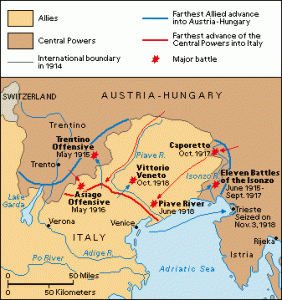
But when the Austrians ran into a British-French rear guard, they were forced to abruptly halt. On the second day of the offensive, they were driven right back to where they'd started, having lost 46,000 men.
By June 25th, their losses were 142,000 men – 11,000 had been killed, and 10,000's had surrendered. Those left were without food or ammunition.
The battle left Austria-Hungary's armies incapable of maintaining a decent defence. Conrad was removed from command on July 25th, and for some reason elevated from baron to count.
The Alpine snows were melting, but desertions were growing. Soon, Austria had to tell Germany that they couldn't continue. If Germany wouldn't join them in seeking peace, then Austria would have to do so alone. But when they tried to approach the Allies, they were rebuffed – they'd left it too late.
Other Problems
In the east, the Treaty of Brest-Litovsk, which had given Germany so much and the Russians so little, was causing Germany major problems – military, political and economic. They had to occupy Kharkov (deep inside Ukraine) in order to maintain any amount of control, and to get grain from that far into their new eastern territories. The Donets Basin had been Petrograd's main source of coal since the war began, and the Germans now had to move into it to get fuel for the railways they'd taken from the Russians (which were in a deplorable condition). And to prevent the Allies from advancing into the Middle East, they had to stretch their communication lines into the Crimea.
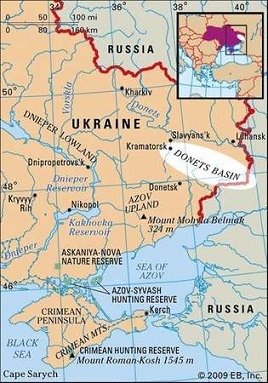
Meanwhile, the Turks had overextended themselves in the Caucasus by advancing in the aftermath of Russia's collapse. In other places, they were disintegrating almost as much as the Austrians. British & Arab forces were defeating & outmaneuvering them in the southern reaches of their dying empire.
But things weren't so great for the Allies, either. Earlier, the German threat to Paris had meant that Clemenceau's government might fall (and the next government might have been willing to negotiate with the Germans), but the threat had ended, and so had those possibilities. Britain & France were desperate because of the casualty levels – Britain was drafting 50-year-olds, and France was organizing combat units that were almost entirely made up of troops over 40yrs old.
At Birmingham and Coventry, ammunitions factory workers went on strike, and returned only when Lloyd George threatened to draft them into the army. In August, Britain's police force declared a one-day strike in protest of inflation's effect on their wages. A railway strike in several regions happened after that.
Strikes were even more widespread in France. The strikers were often wanting to pressurize the government into making peace, as well as aiming for the usual strike goals.
On the surface, 1918 could appear to have been a year of German gains – Germany had taken territory in eastern Europe, and held more territory in France & Flanders than they had in March. The remnants of their army continued with a stubborn defence, slowing the Allied advance to a ridiculously slow pace.
But the Germans were taking extremely high casualties; and because the Allies were constantly attacking, they had no chance to rest, reorganize, or organize decent defences. In August, they took 228,000 casualties – and 110,000 of them were listed as “missing”, i.e. many of them had deserted.
German soldiers were celebrating when they managed to surrender without being killed. When new POWs arrived at the holding pens the Allies had created for the prisoners, those inside welcomed them with cheers. By September, the Germans would have only 125 divisions on the Western Front, of which only 47 would be considered capable of combat. The Allies, meanwhile, would have over 200 divisions, many of them fresh, double-sized American units.
All senior Allied commanders knew that a German victory was impossible, and so did most of the senior German commanders. Germany's only hope was to initiate negotiations before they, like Austria, had nothing left to offer.
#book: a world undone#history#military history#ww1#battle of soissons (1918)#battle of château-thierry#battle of belleau wood#battle of matz#battle of hamel#second battle of the marne#third battle of amiens#second battle of the piave river#germany#britain#france#usa#austria#austria-hungary#ukraine#turkey#noël de castelnau#douglas haig#ferdinand foch#georges clemenceau#henri-philippe pétain#george pershing#georg brüchmuller#erich ludendorff#oskar von hutier#john monash
1 note
·
View note